 |
|
For researchers of the Jeffrey MacDonald case: The murders of Colette, Kimberley and Kristen MacDonald
|

|
|
February 19, 1991
Affidavit of Brian Murtagh
|
|
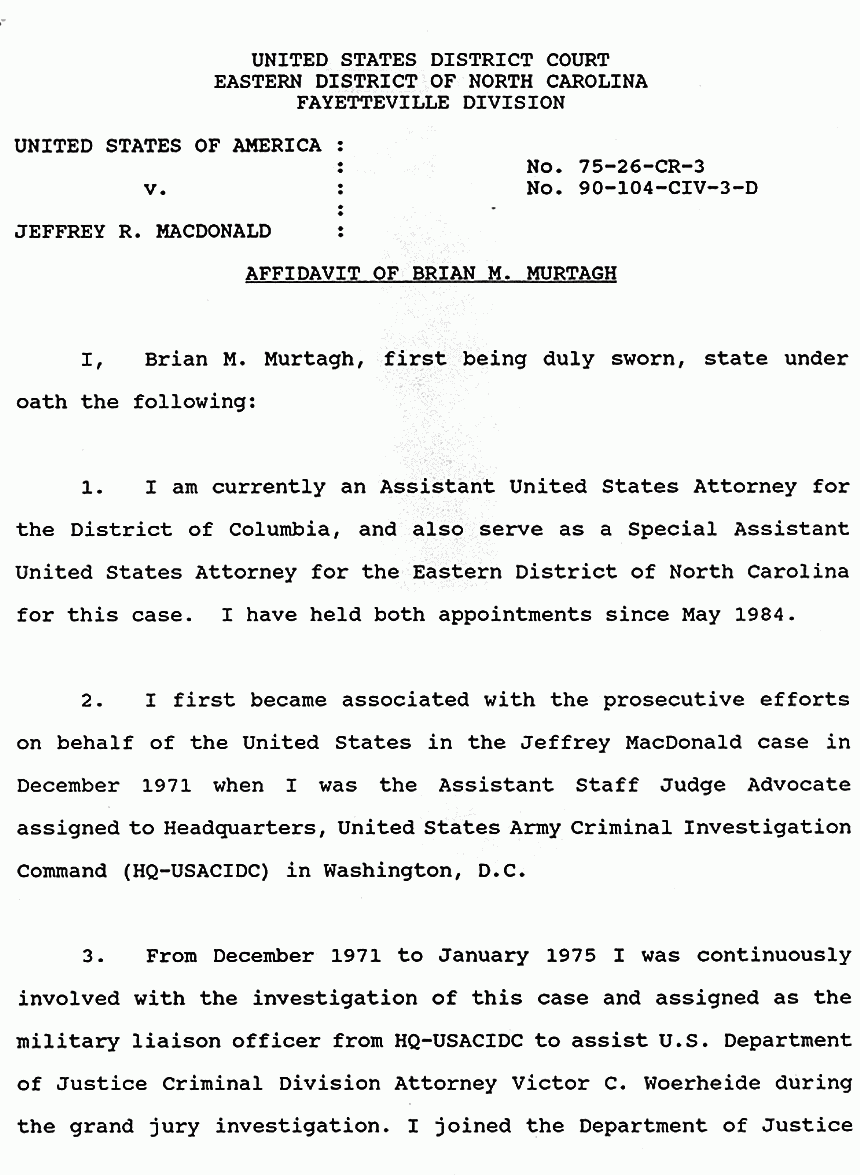
February 19, 1991: Affidavit of Brian Murtagh, page 1 of 37
|
|
February 19, 1991: Affidavit of Brian Murtagh, page 1
Click icon to expand and reduce original image. Drag the expanded image to move it.
|
|
|
|
UNITED STATES DISTRICT COURT
EASTERN DISTRICT OF NORTH CAROLINA
FAYETTEVILLE DIVISION
|
|
UNITED STATES OF AMERICA
|
:
|
|
|
|
:
|
No. 75-26-CR-3
|
|
v.
|
:
|
No. 90-104ĚCIVĚ3-D
|
|
JEFFREY R. MACDONALD
|
:
|
|
|
|
|
|
|
|
AFFIDAVIT OF BRIAN M. MURTAGH
|
|
I, Brian M. Murtagh, first being duly sworn, state under
oath the following:
1. I am currently an Assistant United States Attorney for
the District of Columbia, and also serve as a Special Assistant
United States Attorney for the Eastern District of North Carolina
for this case. I have held both appointments since May 1984.
2. I first became associated with the prosecutive efforts
on behalf of the United States in the Jeffrey MacDonald case in
December 1971 when I was the Assistant Staff Judge Advocate
assigned to Headquarters, United States Army Criminal Investigation
Command (HQ-USACIDC) in Washington, D.C.
3. From December 1971 to January 1975 I was continuously
involved with the investigation of this case and assigned as the
military liaison officer from HQ-USACIDC to assist U.S. Department
of Justice Criminal Division Attorney Victor C. Woerheide during
the grand jury investigation. I joined the Department of Justice
|
|
|
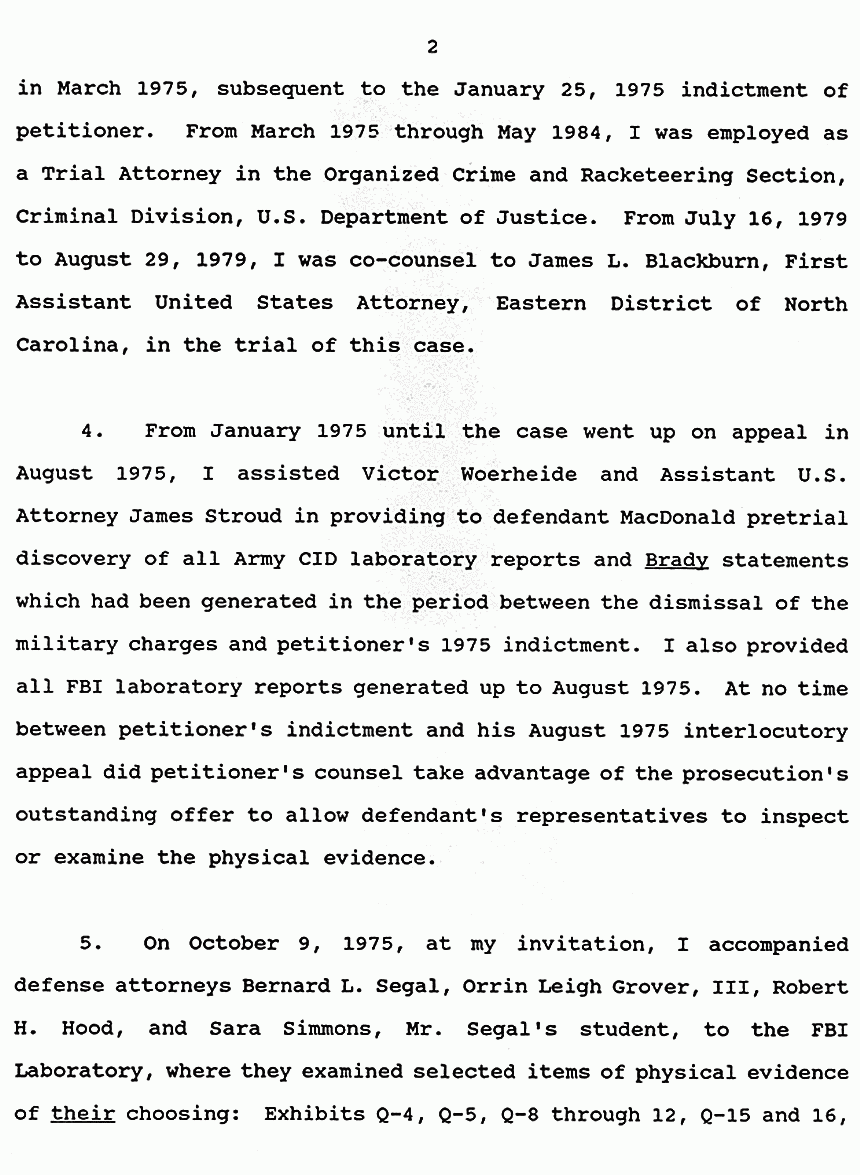
February 19, 1991: Affidavit of Brian Murtagh, page 2 of 37
|
|
February 19, 1991: Affidavit of Brian Murtagh, page 2
Click icon to expand and reduce original image. Drag the expanded image to move it.
|
|
|
|
2
in March 1975, subsequent to the January 25, 1975 indictment of
petitioner. From March 1975 through May 1984, I was employed as
a Trial Attorney in the Organized Crime and Racketeering Section,
Criminal Division, U.S. Department of Justice. From July 16, 1979
to August 29, 1979, I was co-counsel to James L. Blackburn, First
Assistant United States Attorney, Eastern District of North
Carolina, in the trial of this case.
4. From January 1975 until the case went up on appeal in
August 1975, I assisted Victor Woerheide and Assistant U.S.
Attorney James Stroud in providing to defendant MacDonald pretrial
discovery of all Army CID laboratory reports and Brady statements
which had been generated in the period between the dismissal of the
military charges and petitioner's 1975 indictment. I also provided
all FBI laboratory reports generated up to August 1975. At no time
between petitioner's indictment and his August 1975 interlocutory
appeal did petitioner's counsel take advantage of the prosecution's
outstanding offer to allow defendant's representatives to inspect
or examine the physical evidence.
5. On October 9, 1975, at my invitation, I accompanied
defense attorneys Bernard L. Segal, Orrin Leigh Grover, III, Robert
H. Hood, and Sara Simmons, Mr. Segal's student, to the FBI
Laboratory, where they examined selected items of physical evidence
of their choosing: Exhibits Q-4, Q-5, Q-8 through 12, Q-15 and 16,
|
|
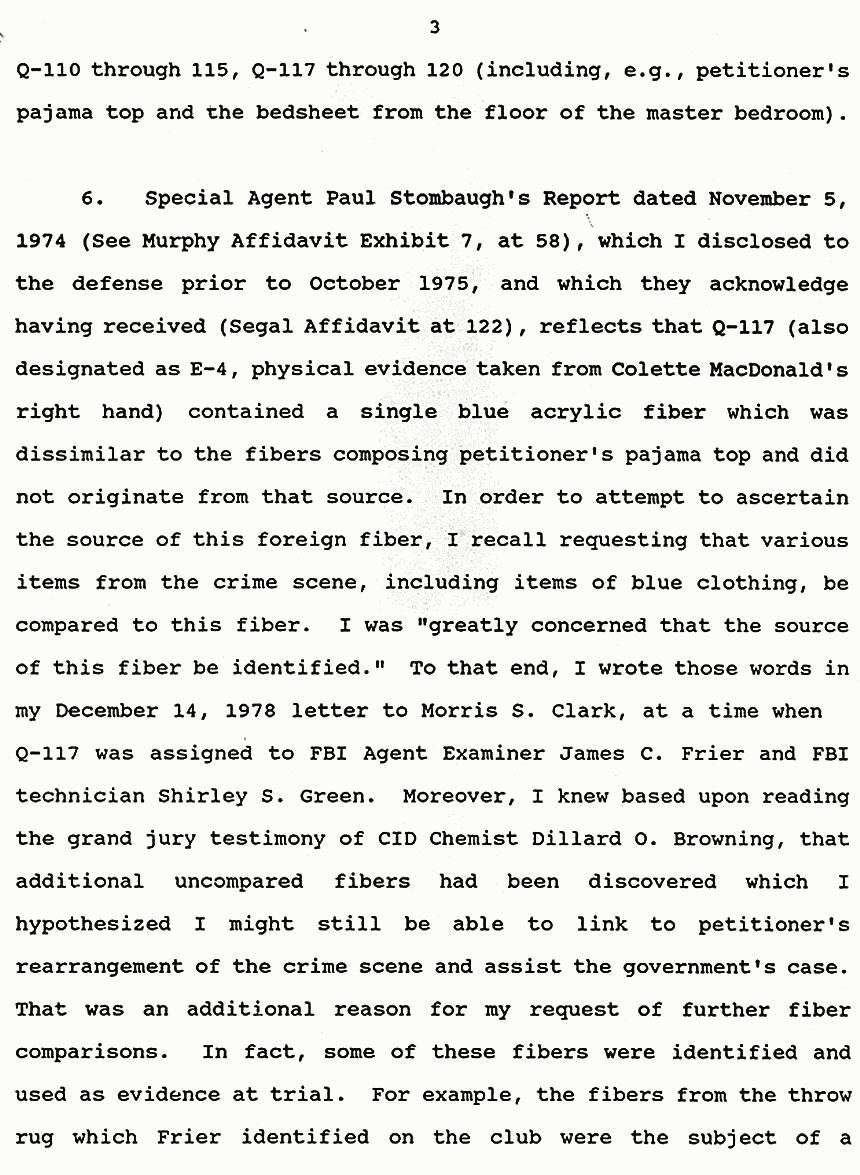
February 19, 1991: Affidavit of Brian Murtagh, page 3 of 37
|
|
February 19, 1991: Affidavit of Brian Murtagh, page 3
Click icon to expand and reduce original image. Drag the expanded image to move it.
|
|
|
|
3
Q-110 through 115, Q-117 through 120 (including, e.g., petitioner's
pajama top and the bedsheet from the floor of the master bedroom).
6. Special Agent Paul Stombaugh's Report dated November 5,
1974 (See Murphy Affidavit Exhibit 7, at 58), which I disclosed to
the defense prior to October 1975, and which they acknowledge
having received (Segal Affidavit at 122), reflects that Q-117 (also
designated as E-4, physical evidence taken from Colette MacDonald's
right hand) contained a single blue acrylic fiber which was
dissimilar to the fibers composing petitioner's pajama top and did
not originate from that source. In order to attempt to ascertain
the source of this foreign fiber, I recall requesting that various
items from the crime scene, including items of blue clothing, be
compared to this fiber. I was "greatly concerned that the source
of this fiber be identified." To that end, I wrote those words in
my December 14, 1978 letter to Morris S. Clark, at a time when
Q-117 was assigned to FBI Agent Examiner James C. Frier and FBI
technician Shirley S. Green. Moreover, I knew based upon reading
the grand jury testimony of CID Chemist Dillard O. Browning, that
additional uncompared fibers had been discovered which I
hypothesized I might still be able to link to petitioner's
rearrangement of the crime scene and assist the government's case.
That was an additional reason for my request of further fiber
comparisons. In fact, some of these fibers were identified and
used as evidence at trial. For example, the fibers from the throw
rug which Frier identified on the club were the subject of a
|
|
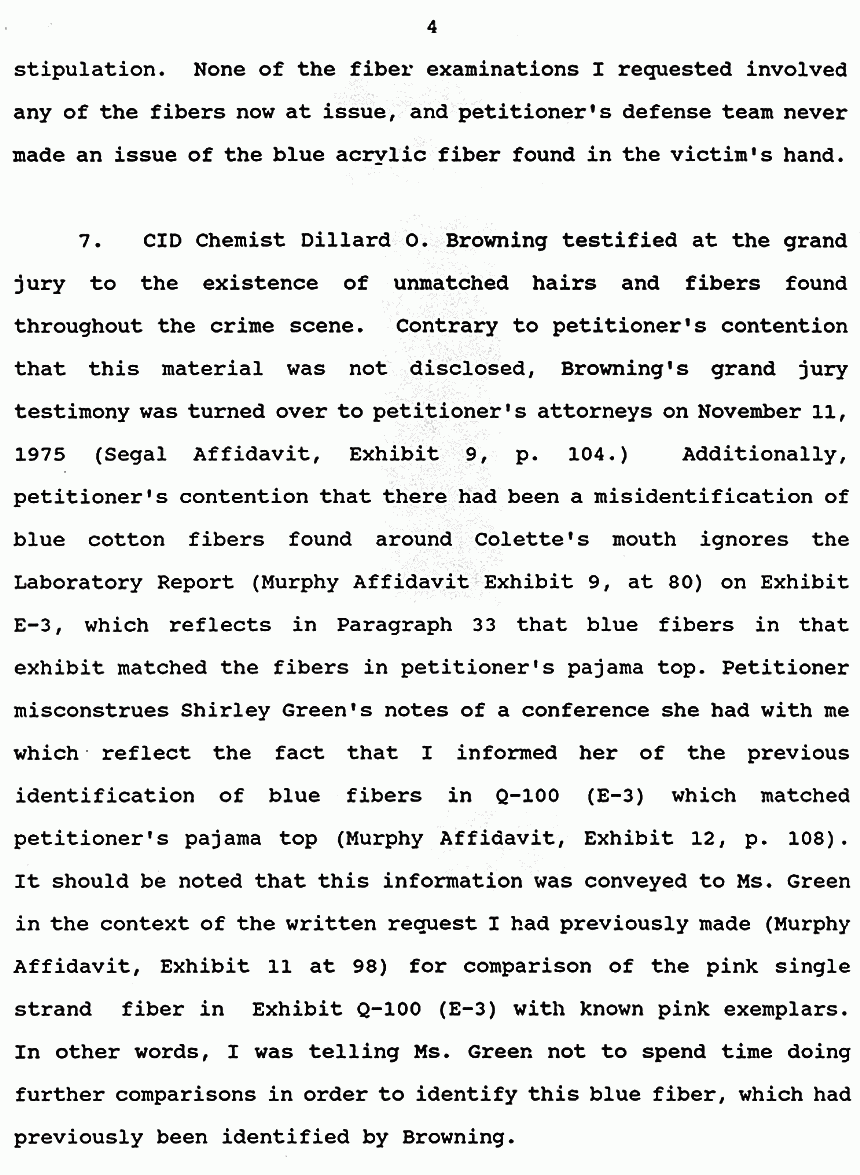
February 19, 1991: Affidavit of Brian Murtagh, page 4 of 37
|
|
February 19, 1991: Affidavit of Brian Murtagh, page 4
Click icon to expand and reduce original image. Drag the expanded image to move it.
|
|
|
|
4
stipulation. None of the fiber examinations I requested involved
any of the fibers now at issue, and petitioner's defense team never
made an issue of the blue acrylic fiber found in the victim's hand.
7. CID Chemist Dillard O. Browning testified at the grand
jury to the existence of unmatched hairs and fibers found
throughout the crime scene. Contrary to petitioner's contention
that this material was not disclosed, Browning's grand jury
testimony was turned over to petitioner's attorneys on November 11,
1975 (Segal Affidavit, Exhibit 9, p. 104.) Additionally,
petitioner's contention that there had been a misidentification of
blue cotton fibers found around Colette's mouth ignores the
Laboratory Report (Murphy Affidavit Exhibit 9, at 80) on Exhibit
E-3, which reflects in Paragraph 33 that blue fibers in that
exhibit matched the fibers in petitioner's pajama top. Petitioner
misconstrues Shirley Green's notes of a conference she had with me
which reflect the fact that I informed her of the previous
identification of blue fibers in Q-100 (E-3) which matched
petitioner's pajama top (Murphy Affidavit, Exhibit 12, p. 108).
It should be noted that this information was conveyed to Ms. Green
in the context of the written request I had previously made (Murphy
Affidavit, Exhibit 11 at 98) for comparison of the pink single
strand fiber in Exhibit Q-100 (E-3) with known pink exemplars.
In other words, I was telling Ms. Green not to spend time doing
further comparisons in order to identify this blue fiber, which had
previously been identified by Browning.
|
|
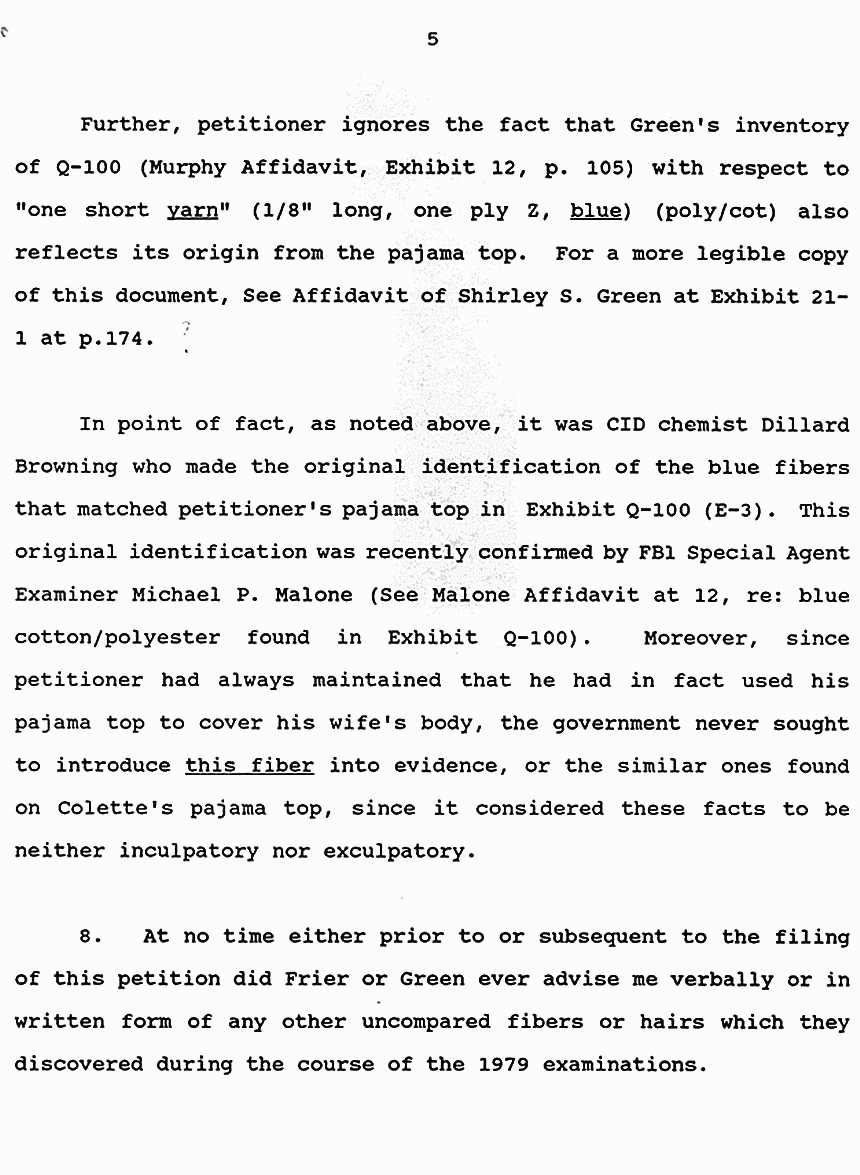
February 19, 1991: Affidavit of Brian Murtagh, page 5 of 37
|
|
February 19, 1991: Affidavit of Brian Murtagh, page 5
Click icon to expand and reduce original image. Drag the expanded image to move it.
|
|
|
5
Further, petitioner ignores the fact that Green's inventory
of Q-100 (Murphy Affidavit, Exhibit 12, p. 105) with respect to
"one short yarn" (1/8" long, one ply Z, blue) (poly/cot) also
reflects its origin from the pajama top. For a more legible copy
of this document, See Affidavit of Shirley S. Green at Exhibit 21-
1 at p.174.
In point of fact, as noted above, it was CID chemist Dillard
Browning who made the original identification of the blue fibers
that matched petitioner's pajama top in Exhibit Q-100 (E-3). This
original identification was recently confirmed by FBI Special Agent
Examiner Michael P. Malone (See Malone Affidavit at 12, re: blue
cotton/polyester found in Exhibit Q-100). Moreover, since
petitioner had always maintained that he had in fact used his
pajama top to cover his wife's body, the government never sought
to introduce this fiber into evidence, or the similar ones found
on Colette's pajama top, since it considered these facts to be
neither inculpatory nor exculpatory.
8. At no time either prior to or subsequent to the filing
of this petition did Frier or Green ever advise me verbally or in
written form of any other uncompared fibers or hairs which they
discovered during the course of the 1979 examinations.
|
|
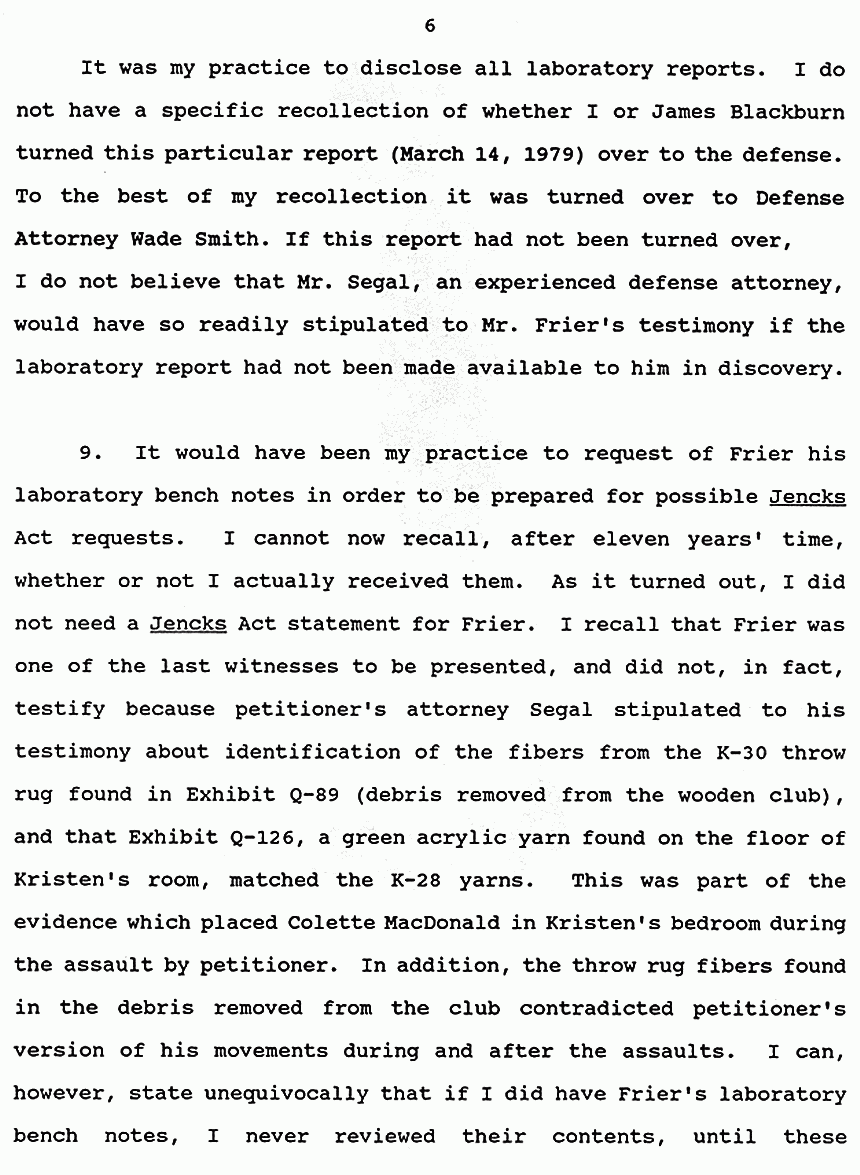
February 19, 1991: Affidavit of Brian Murtagh, page 6 of 37
|
|
February 19, 1991: Affidavit of Brian Murtagh, page 6
Click icon to expand and reduce original image. Drag the expanded image to move it.
|
|
|
|
6
It was my practice to disclose all laboratory reports. I do
not have a specific recollection of whether I or James Blackburn
turned this particular report (March 14, 1979) over to the defense.
To the best of my recollection it was turned over to Defense
Attorney Wade Smith. If this report had not been turned over,
I do not believe that Mr. Segal, an experienced defense attorney,
would have so readily stipulated to Mr. Frier's testimony if the
laboratory report had not been made available to him in discovery.
9. It would have been my practice to request of Frier his
laboratory bench notes in order to be prepared for possible Jencks
Act requests. I cannot now recall, after eleven years' time,
whether or not I actually received them. As it turned out, I did
not need a Jencks Act statement for Frier. I recall that Frier was
one of the last witnesses to be presented, and did not, in fact,
testify because petitioner's attorney Segal stipulated to his
testimony about identification of the fibers from the K-30 throw
rug found in Exhibit Q-89 (debris removed from the wooden club),
and that Exhibit Q-126, a green acrylic yarn found on the floor of
Kristen's room, matched the K-28 yarns. This was part of the
evidence which placed Colette MacDonald in Kristen's bedroom during
the assault by petitioner. In addition, the throw rug fibers found
in the debris removed from the club contradicted petitioner's
version of his movements during and after the assaults. I can,
however, state unequivocally that if I did have Frier's laboratory
bench notes, I never reviewed their contents, until these
|
|
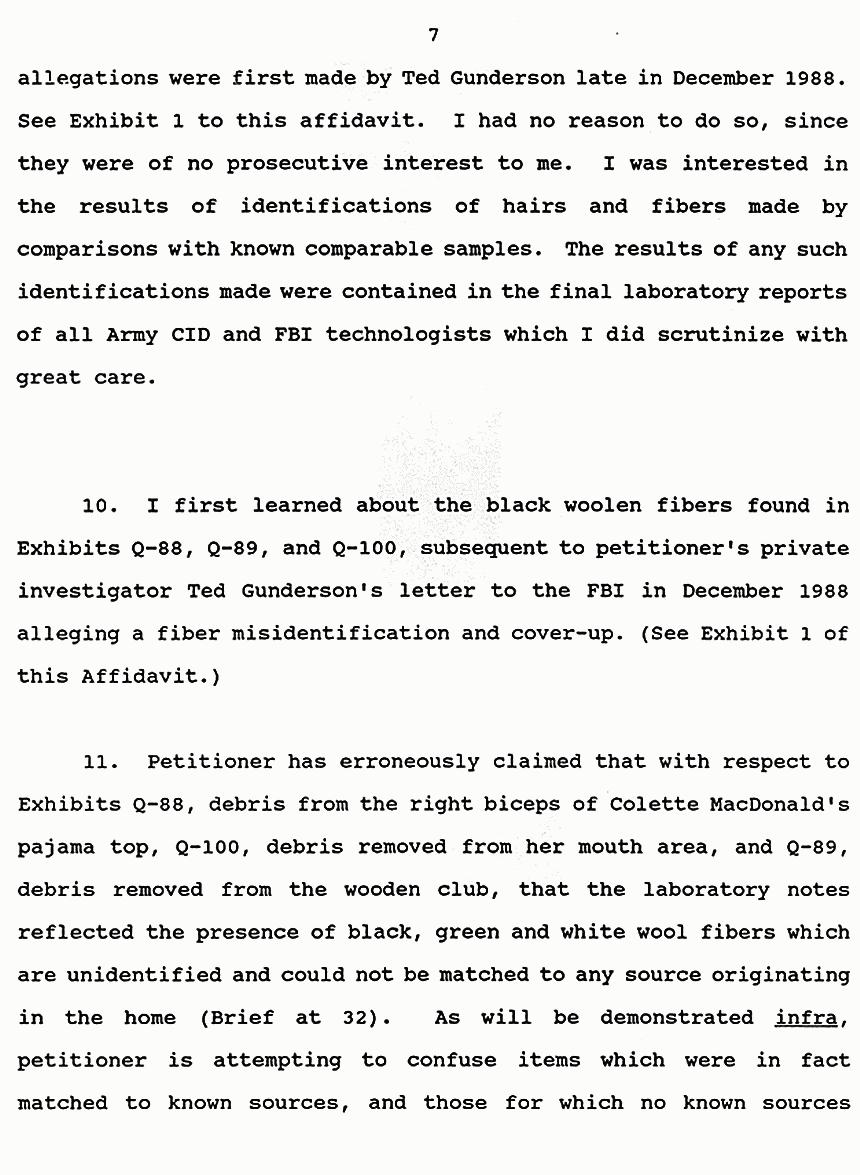
February 19, 1991: Affidavit of Brian Murtagh, page 7 of 37
|
|
February 19, 1991: Affidavit of Brian Murtagh, page 7
Click icon to expand and reduce original image. Drag the expanded image to move it.
|
|
|
|
7
allegations were first made by Ted Gunderson late in December 1988.
See Exhibit 1 to this affidavit. I had no reason to do so, since
they were of no prosecutive interest to me. I was interested in
the results of identifications of hairs and fibers made by
comparisons with known comparable samples. The results of any such
identifications made were contained in the final laboratory reports
of all Army CID and FBI technologists which I did scrutinize with
great care.
10. I first learned about the black woolen fibers found in
Exhibits Q-88, Q-89, and Q-100, subsequent to petitioner's private
investigator Ted Gunderson's letter to the FBI in December 1988
alleging a fiber misidentification and cover-up. (See Exhibit 1 of
this Affidavit.)
11. Petitioner has erroneously claimed that with respect to
Exhibits Q-88, debris from the right biceps of Colette MacDonald's
pajama top, Q-100, debris removed from her mouth area, and Q-89,
debris removed from the wooden club, that the laboratory notes
reflected the presence of black, green and white wool fibers which
are unidentified and could not be matched to any source originating
in the home (Brief at 32). As will be demonstrated infra,
petitioner is attempting to confuse items which were in fact
matched to known sources, and those for which no known sources
|
|
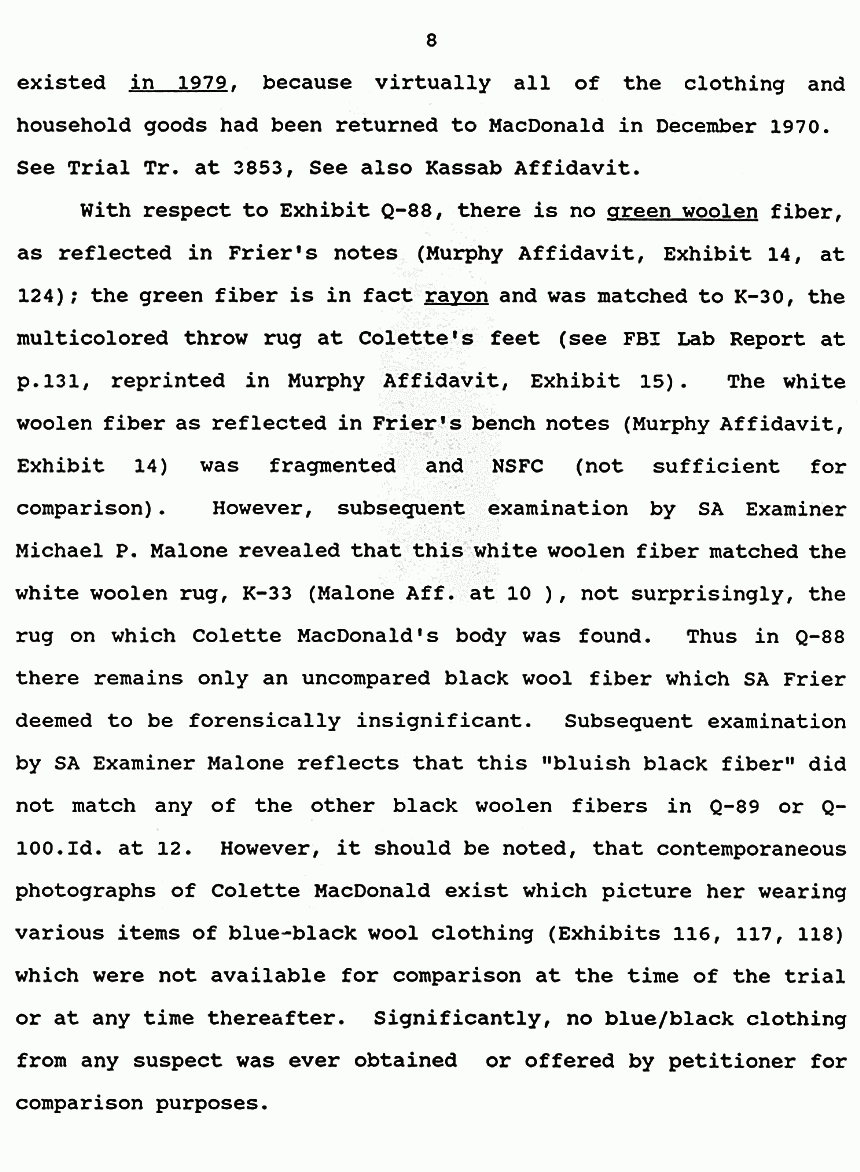
February 19, 1991: Affidavit of Brian Murtagh, page 8 of 37
|
|
February 19, 1991: Affidavit of Brian Murtagh, page 8
Click icon to expand and reduce original image. Drag the expanded image to move it.
|
|
|
|
8
existed in 1979, because virtually all of the clothing and
household goods had been returned to MacDonald in December 1970.
See Trial Tr. at 3853, See also Kassab Affidavit.
With respect to Exhibit Q-88, there is no green woolen fiber,
as reflected in Frier's notes (Murphy Affidavit, Exhibit 14, at
124); the green fiber is in fact rayon and was matched to K-30, the
multicolored throw rug at Colette's feet (see FBI Lab Report at
p.131, reprinted in Murphy Affidavit, Exhibit 15). The white
woolen fiber as reflected in Frier's bench notes (Murphy Affidavit,
Exhibit 14) was fragmented and NSFC (not sufficient for
comparison). However, subsequent examination by SA Examiner
Michael P. Malone revealed that this white woolen fiber matched the
white woolen rug, K-33 (Malone Aff. at 10 ), not surprisingly, the
rug on which Colette MacDonald's body was found. Thus in Q-88
there remains only an uncompared black wool fiber which SA Frier
deemed to be forensically insignificant. Subsequent examination
by SA Examiner Malone reflects that this "bluish black fiber" did
not match any of the other black woolen fibers in Q-89 or Q-
100.Id. at 12. However, it should be noted, that contemporaneous
photographs of Colette MacDonald exist which picture her wearing
various items of blue-black wool clothing (Exhibits 116, 117, 118)
which were not available for comparison at the time of the trial
or at any time thereafter. Significantly, no blue/black clothing
from any suspect was ever obtained or offered by petitioner for
comparison purposes.
|
|
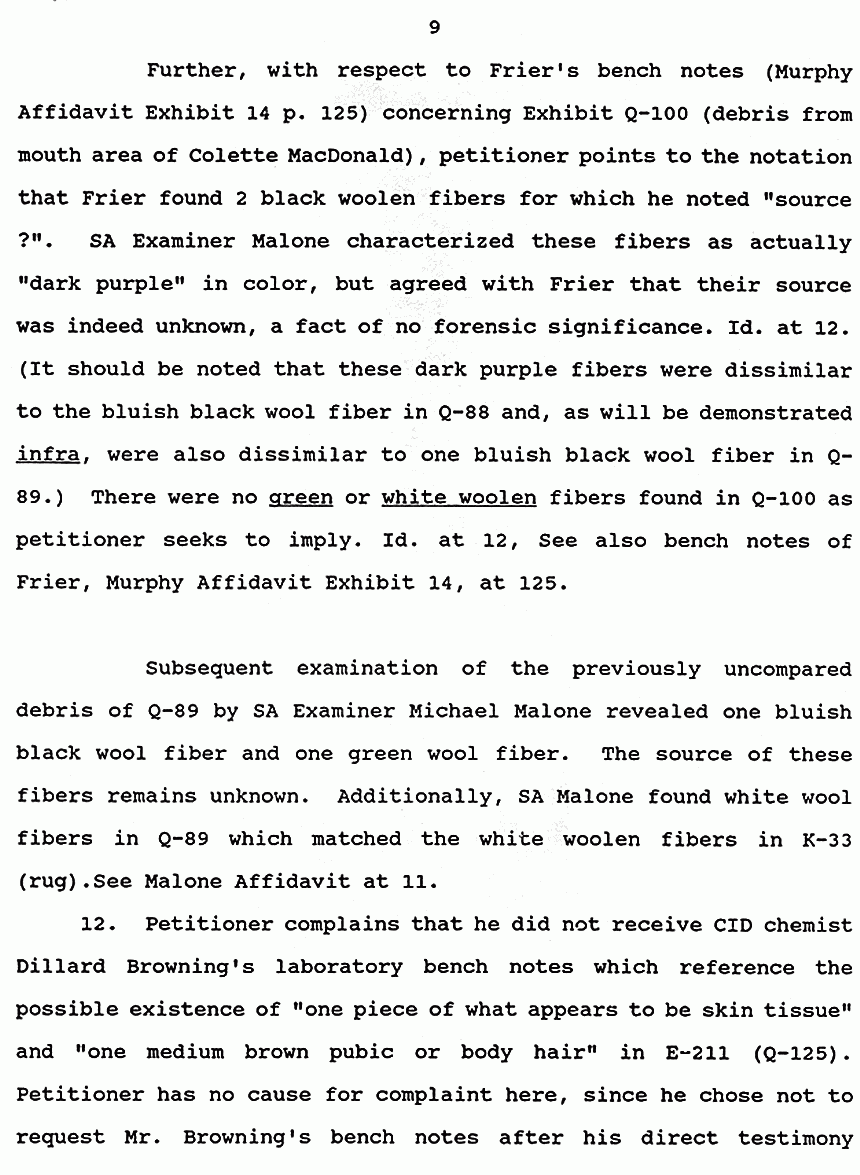
February 19, 1991: Affidavit of Brian Murtagh, page 9 of 37
|
|
February 19, 1991: Affidavit of Brian Murtagh, page 9
Click icon to expand and reduce original image. Drag the expanded image to move it.
|
|
|
|
9
Further, with respect to Frier's bench notes (Murphy
Affidavit Exhibit 14 p. 125) concerning Exhibit Q-100 (debris from
mouth area of Colette MacDonald), petitioner points to the notation
that Frier found 2 black woolen fibers for which he noted "source
?". SA Examiner Malone characterized these fibers as actually
"dark purple" in color, but agreed with Frier that their source
was indeed unknown, a fact of no forensic significance. Id. at 12.
(It should be noted that these dark purple fibers were dissimilar
to the bluish black wool fiber in Q-88 and, as will be demonstrated
infra, were also dissimilar to one bluish black wool fiber in Q-
89.) There were no green or white woolen fibers found in Q-100 as
petitioner seeks to imply. Id. at 12, See also bench notes of
Frier, Murphy Affidavit Exhibit 14, at 125.
Subsequent examination of the previously uncompared
debris of Q-89 by SA Examiner Michael Malone revealed one bluish
black wool fiber and one green wool fiber. The source of these
fibers remains unknown. Additionally, SA Malone found white wool
fibers in Q-89 which matched the white woolen fibers in K-33
(rug).See Malone Affidavit at 11.
12. Petitioner complains that he did not receive CID chemist
Dillard Browning's laboratory bench notes which reference the
possible existence of "one piece of what appears to be skin tissue"
and "one medium brown pubic or body hair" in E-211 (Q-125).
Petitioner has no cause for complaint here, since he chose not to
request Mr. Browning's bench notes after his direct testimony
|
|
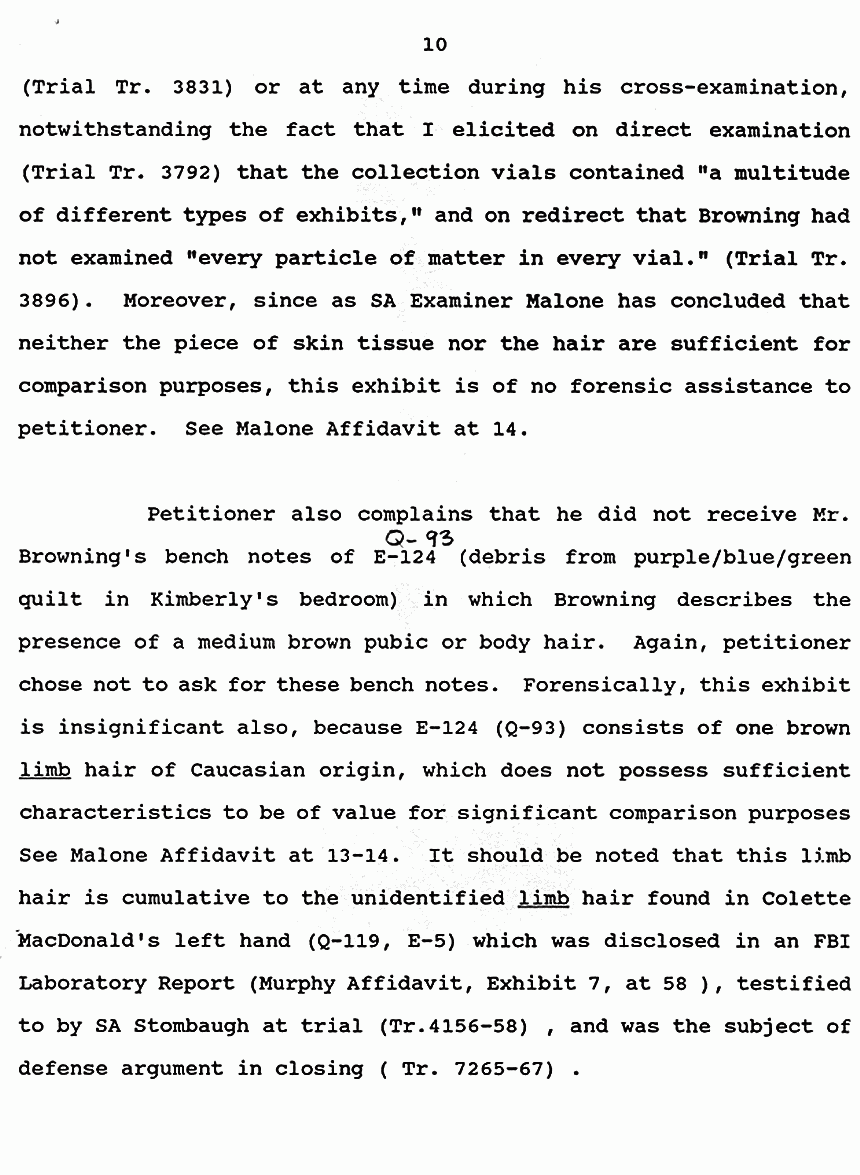
February 19, 1991: Affidavit of Brian Murtagh, page 10 of 37
|
|
February 19, 1991: Affidavit of Brian Murtagh, page 10
Click icon to expand and reduce original image. Drag the expanded image to move it.
|
|
|
|
10
(Trial Tr. 3831) or at any time during his cross-examination,
notwithstanding the fact that I elicited on direct examination
(Trial Tr. 3792) that the collection vials contained "a multitude
of different types of exhibits," and on redirect that Browning had
not examined "every particle of matter in every vial." (Trial Tr.
3896). Moreover, since as SA Examiner Malone has concluded that
neither the piece of skin tissue nor the hair are sufficient for
comparison purposes, this exhibit is of no forensic assistance to
petitioner. See Malone Affidavit at 14.
Petitioner also complains that he did not receive Mr.

Browning's bench notes of E-124 (debris from purple/blue/green
quilt in Kimberly's bedroom) in which Browning describes the
presence of a medium brown pubic or body hair. Again, petitioner
chose not to ask for these bench notes. Forensically, this exhibit
is insignificant also, because E-124 (Q-93) consists of one brown
limb hair of Caucasian origin, which does not possess sufficient
characteristics to be of value for significant comparison purposes
See Malone Affidavit at 13-14. It should be noted that this limb
hair is cumulative to the unidentified limb hair found in Colette
`MacDonald's left hand (Q-119, E-5) which was disclosed in an FBI
Laboratory Report (Murphy Affidavit, Exhibit 7, at 58 ), testified
to by SA Stombaugh at trial (Tr.4156-58) , and was the subject of
defense argument in closing ( Tr. 7265-67) .
|
|
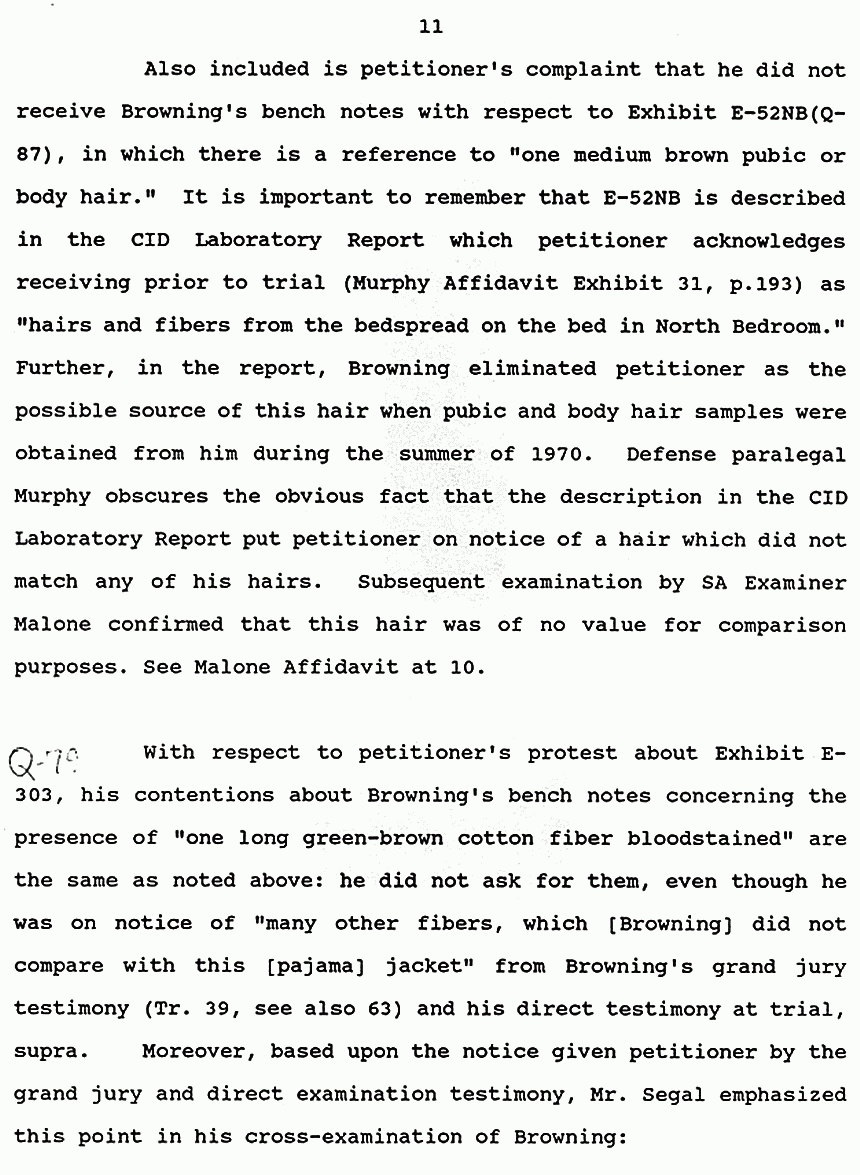
February 19, 1991: Affidavit of Brian Murtagh, page 11 of 37
|
|
February 19, 1991: Affidavit of Brian Murtagh, page 11
Click icon to expand and reduce original image. Drag the expanded image to move it.
|
|
|
|
11
Also included is petitioner's complaint that he did not
receive Browning's bench notes with respect to Exhibit E-52NB(Q-
87), in which there is a reference to "one medium brown pubic or
body hair." It is important to remember that E-52NB is described
in the CID Laboratory Report which petitioner acknowledges
receiving prior to trial (Murphy Affidavit Exhibit 31, p.l93) as
"hairs and fibers from the bedspread on the bed in North Bedroom."
Further, in the report, Browning eliminated petitioner as the
possible source of this hair when pubic and body hair samples were
obtained from him during the summer of 1970. Defense paralegal
Murphy obscures the obvious fact that the description in the CID
Laboratory Report put petitioner on notice of a hair which did not
match any of his hairs. Subsequent examination by SA Examiner
Malone confirmed that this hair was of no value for comparison
purposes. See Malone Affidavit at 10.
 With respect to petitioner's protest about Exhibit E-
303, his contentions about Browning's bench notes concerning the
presence of "one long green-brown cotton fiber bloodstained" are
the same as noted above: he did not ask for them, even though he
was on notice of "many other fibers, which [Browning] did not
compare with this [pajama] jacket" from Browning's grand jury
testimony (Tr. 39, see also 63) and his direct testimony at trial,
supra. Moreover, based upon the notice given petitioner by the
grand jury and direct examination testimony, Mr. Segal emphasized
this point in his cross-examination of Browning: With respect to petitioner's protest about Exhibit E-
303, his contentions about Browning's bench notes concerning the
presence of "one long green-brown cotton fiber bloodstained" are
the same as noted above: he did not ask for them, even though he
was on notice of "many other fibers, which [Browning] did not
compare with this [pajama] jacket" from Browning's grand jury
testimony (Tr. 39, see also 63) and his direct testimony at trial,
supra. Moreover, based upon the notice given petitioner by the
grand jury and direct examination testimony, Mr. Segal emphasized
this point in his cross-examination of Browning:
|
|
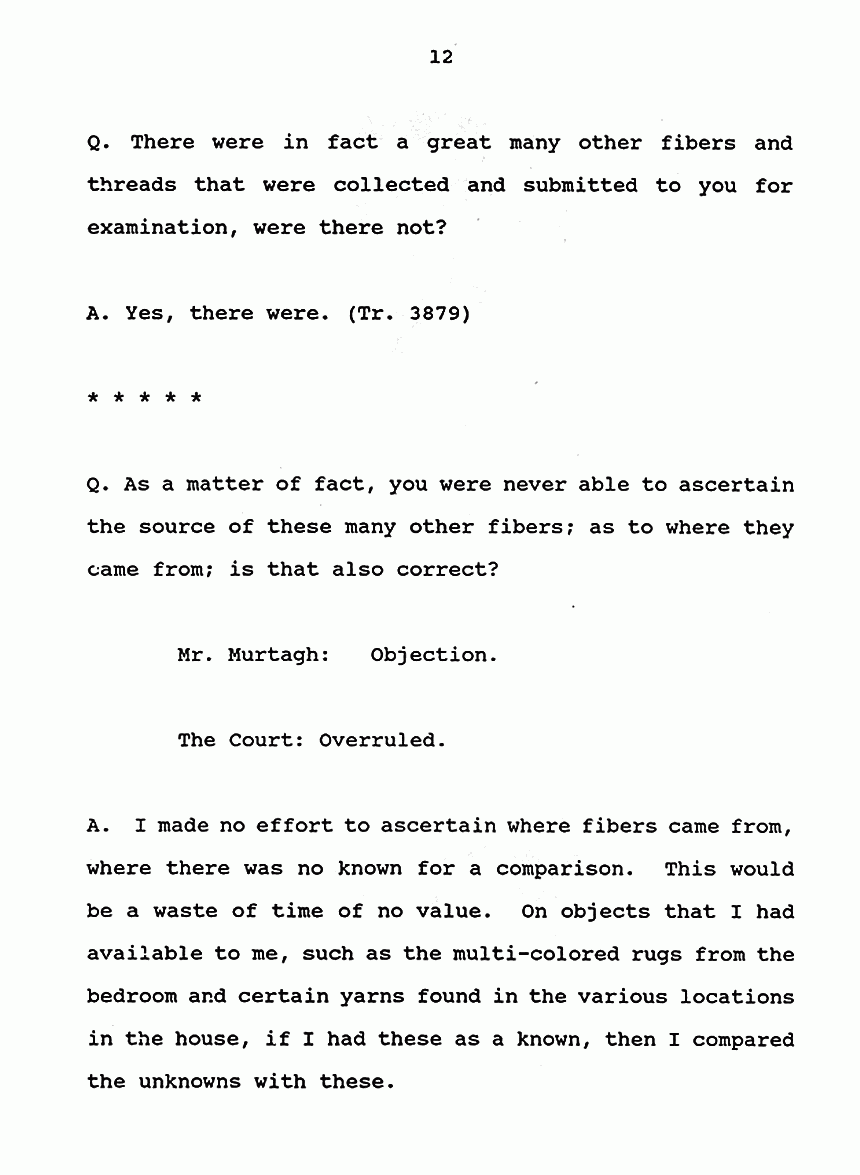
February 19, 1991: Affidavit of Brian Murtagh, page 12 of 37
|
|
February 19, 1991: Affidavit of Brian Murtagh, page 12
Click icon to expand and reduce original image. Drag the expanded image to move it.
|
|
|
12
Q. There were in fact a great many other fibers and
threads that were collected and submitted to you for
examination, were there not?
A. Yes, there were. (Tr. 3879)
* * * * *
Q. As a matter of fact, you were never able to ascertain
the source of these many other fibers; as to where they
came from; is that also correct?
Mr. Murtagh: Objection.
The Court: Overruled.
A. I made no effort to ascertain where fibers came from,
where there was no known for a comparison. This would
be a waste of time of no value. On objects that I had
available to me, such as the multi-colored rugs from the
bedroom and certain yarns found in the various locations
in the house, if I had these as a known, then I compared
the unknowns with these.
|
|
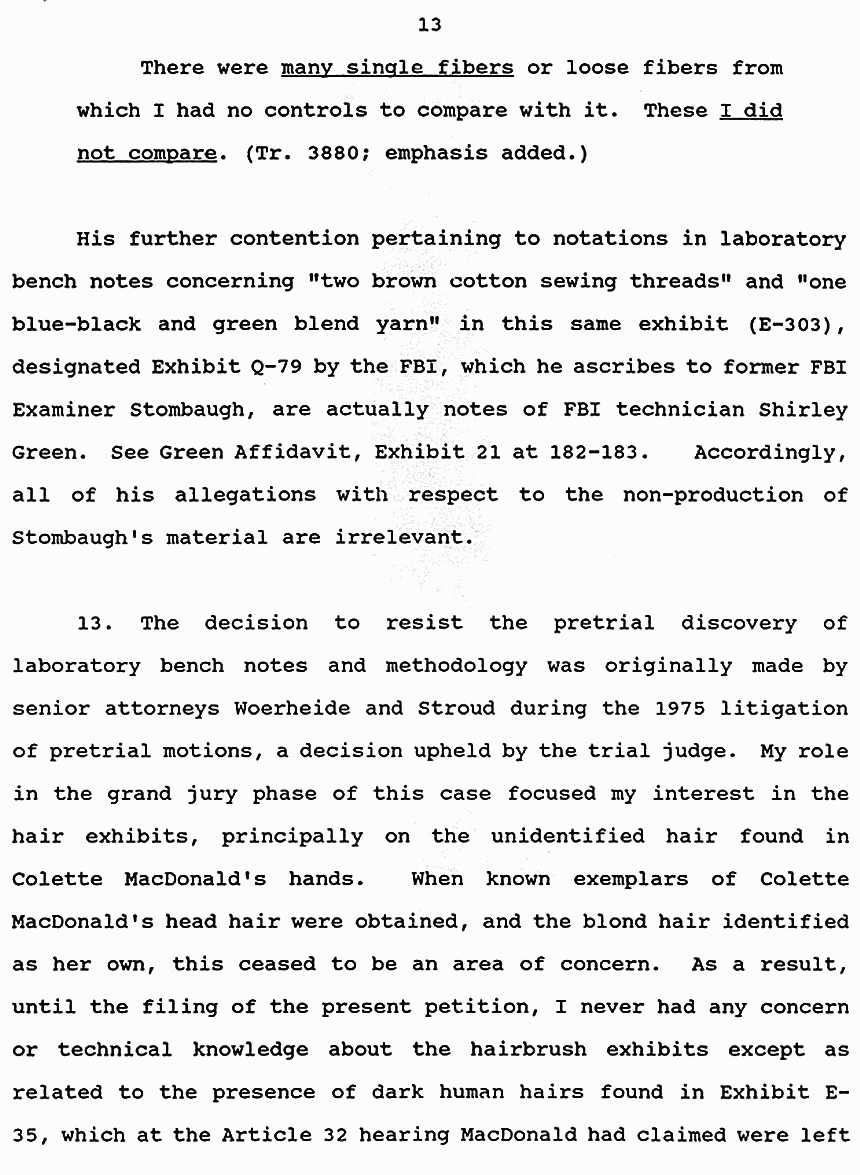
February 19, 1991: Affidavit of Brian Murtagh, page 13 of 37
|
|
February 19, 1991: Affidavit of Brian Murtagh, page 13
Click icon to expand and reduce original image. Drag the expanded image to move it.
|
|
|
|
13
There were many single fibers or loose fibers from
which I had no controls to compare with it. These I did
not compare. (Tr. 3880: emphasis added.)
His further contention pertaining to notations in laboratory
bench notes concerning "two brown cotton sewing threads" and "one
blue-black and green blend yarn" in this same exhibit (E-303),
designated Exhibit Q-79 by the FBI, which he ascribes to former FBI
Examiner Stombaugh, are actually notes of FBI technician Shirley
Green. See Green Affidavit, Exhibit 21 at 182-183. Accordingly,
all of his allegations with respect to the non-production of
Stombaugh's material are irrelevant.
13. The decision to resist the pretrial discovery of
laboratory bench notes and methodology was originally made by
senior attorneys Woerheide and Stroud during the 1975 litigation
of pretrial motions, a decision upheld by the trial judge. My role
in the grand jury phase of this case focused my interest in the
hair exhibits, principally on the unidentified, hair found in
Colette MacDonald's hands. When known exemplars of Colette
MacDonald's head hair were obtained, and the blond hair identified
as her own, this ceased to be an area of concern. As a result,
until the filing of the present petition, I never had any concern
or technical knowledge about the hairbrush exhibits except as
related to the presence of dark human hairs found in Exhibit E-
35, which at the Article 32 hearing MacDonald had claimed were left
|
|
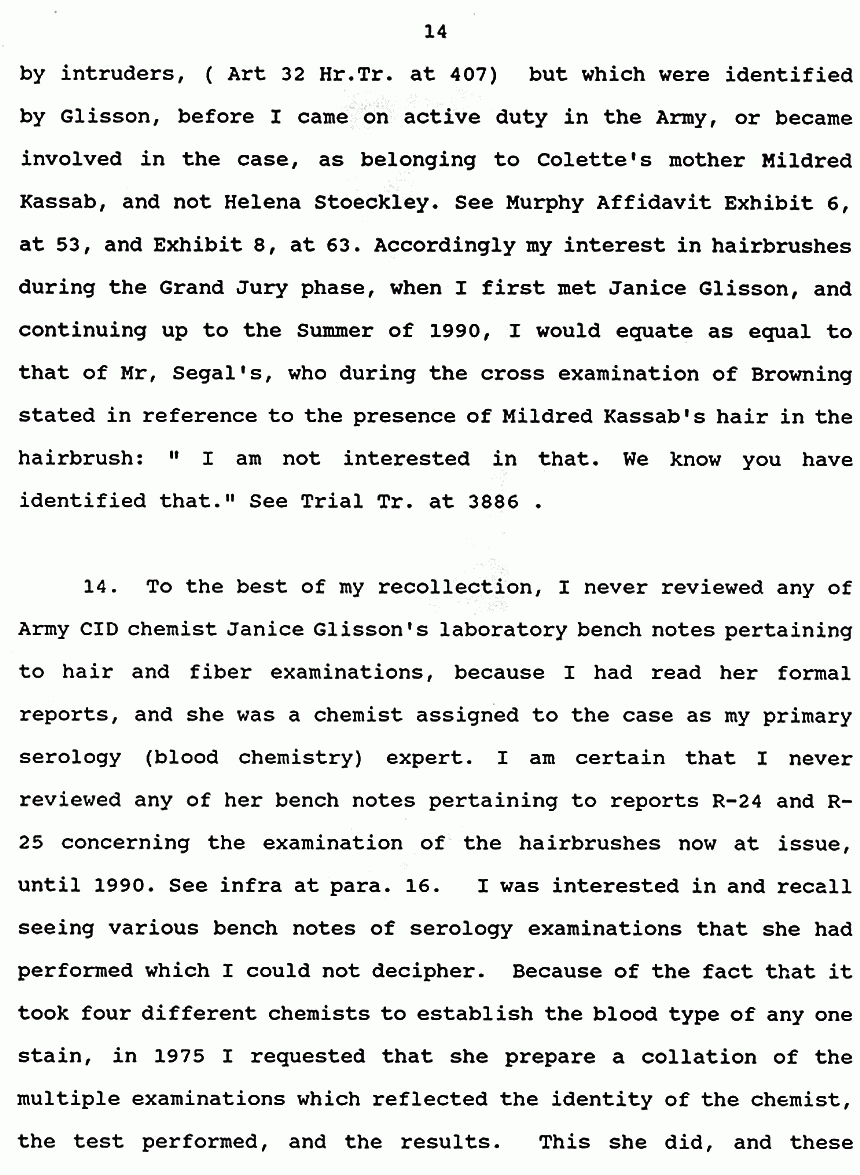
February 19, 1991: Affidavit of Brian Murtagh, page 14 of 37
|
|
February 19, 1991: Affidavit of Brian Murtagh, page 14
Click icon to expand and reduce original image. Drag the expanded image to move it.
|
|
|
|
14
by intruders, ( Art 32 Hr.Tr. at 407) but which were identified
by Glisson, before I came on active duty in the Army, or became
involved in the case, as belonging to Colette's mother Mildred
Kassab, and not Helena Stoeckley. See Murphy Affidavit Exhibit 6,
at 53, and Exhibit 8, at 63. Accordingly my interest in hairbrushes
during the Grand Jury phase, when I first met Janice Glisson, and
continuing up to the Summer of 1990, I would equate as equal to
that of Mr, Segal's, who during the cross examination of Browning
stated in reference to the presence of Mildred Kassab's hair in the
hairbrush: " I am not interested in that. We know you have
identified that." See Trial Tr. at 3886 .
14. To the best of my recollection, I never reviewed any of
Army CID chemist Janice Glisson's laboratory bench notes pertaining
to hair and fiber examinations, because I had read her formal
reports, and she was a chemist assigned to the case as my primary
serology (blood chemistry) expert. I am certain that I never
reviewed any of her bench notes pertaining to reports R-24 and R-
25 concerning the examination of the hairbrushes now at issue,
until 1990. See infra at para. 16. I was interested in and recall
seeing various bench notes of serology examinations that she had
performed which I could not decipher. Because of the fact that it
took four different chemists to establish the blood type of any one
stain, in 1975 I requested that she prepare a collation of the
multiple examinations which reflected the identity of the chemist,
the test performed, and the results. This she did, and these
|
|
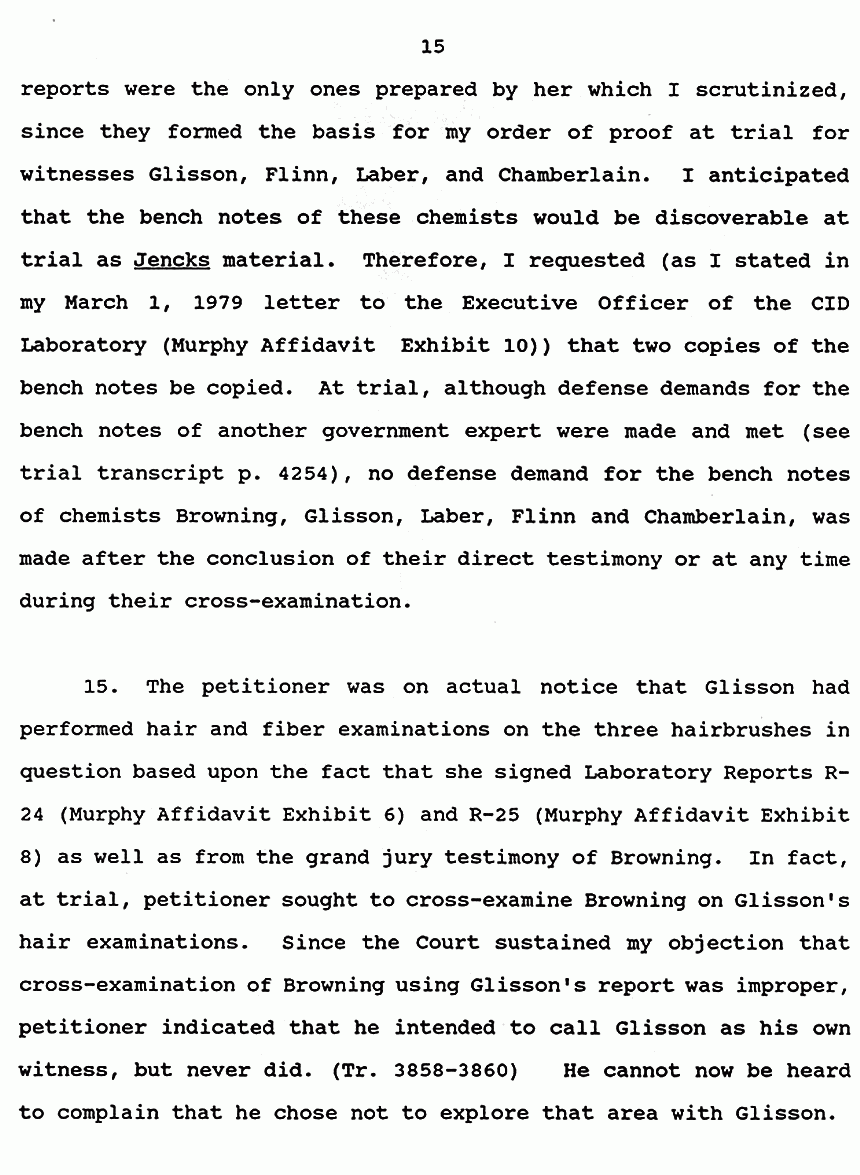
February 19, 1991: Affidavit of Brian Murtagh, page 15 of 37
|
|
February 19, 1991: Affidavit of Brian Murtagh, page 15
Click icon to expand and reduce original image. Drag the expanded image to move it.
|
|
|
|
15
reports were the only ones prepared by her which I scrutinized,
since they formed the basis for my order of proof at trial for
witnesses Glisson, Flinn, Laber, and Chamberlain. I anticipated
that the bench notes of these chemists would be discoverable at
trial as Jencks material. Therefore, I requested (as I stated in
my March 1, 1979 letter to the Executive Officer of the CID
Laboratory (Murphy Affidavit Exhibit 10)) that two copies of the
bench notes be copied. At trial, although defense demands for the
bench notes of another government expert were made and met (see
trial transcript p. 4254), no defense demand for the bench notes
of chemists Browning, Glisson, Laber, Flinn and Chamberlain, was
made after the conclusion of their direct testimony or at any time
during their cross-examination.
15. The petitioner was on actual notice that Glisson had
performed hair and fiber examinations on the three hairbrushes in
question based upon the fact that she signed Laboratory Reports R-
24 (Murphy Affidavit Exhibit 6) and R-25 (Murphy Affidavit Exhibit
8) as well as from the grand jury testimony of Browning. In fact,
at trial, petitioner sought to cross-examine Browning on G1isson's
hair examinations. Since the Court sustained my objection that
cross-examination of Browning using G1isson's report was improper,
petitioner indicated that he intended to call Glisson as his own
witness, but never did. (Tr. 3858-3860) He cannot now be heard
to complain that he chose not to explore that area with Glisson.
|
|
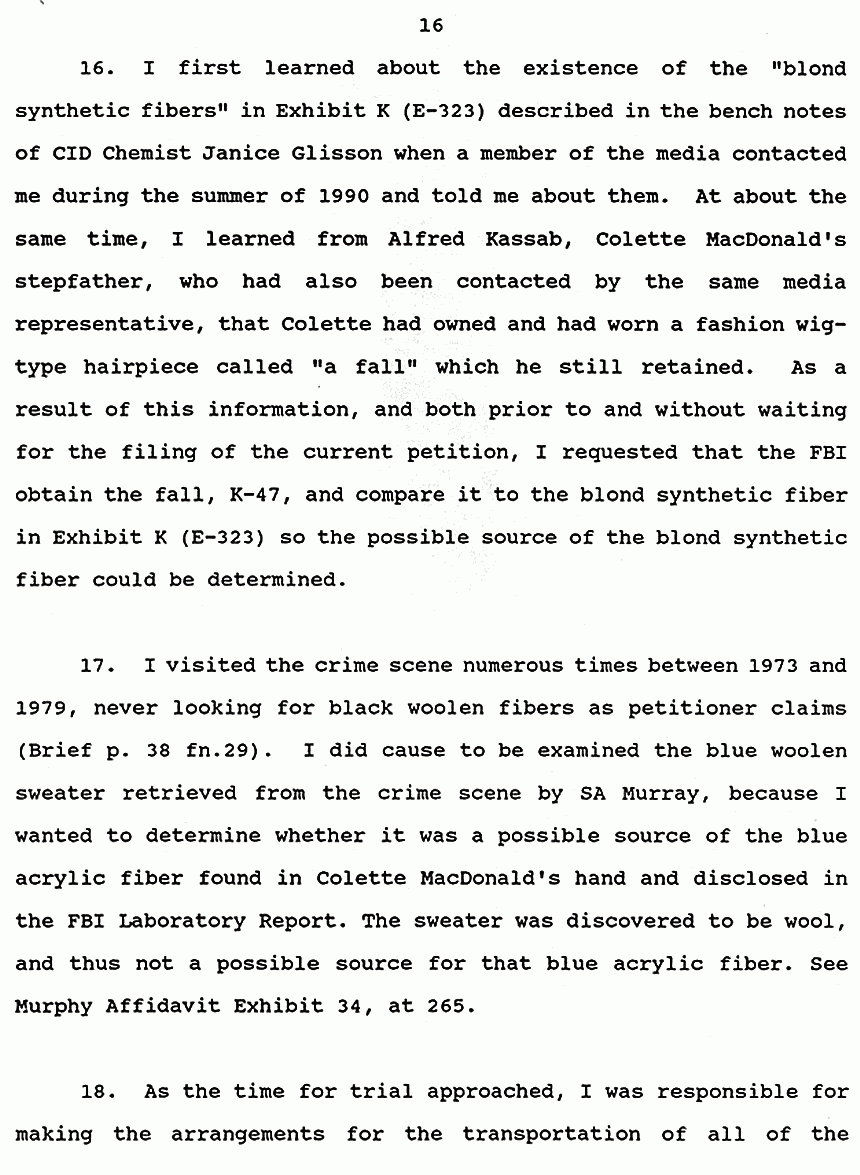
February 19, 1991: Affidavit of Brian Murtagh, page 16 of 37
|
|
February 19, 1991: Affidavit of Brian Murtagh, page 16
Click icon to expand and reduce original image. Drag the expanded image to move it.
|
|
|
|
16
16. I first learned about the existence of the "blond
synthetic fibers" in Exhibit K (E-323) described in the bench notes
of CID Chemist Janice Glisson when a member of the media contacted
me during the summer of 1990 and told me about them. At about the
same time, I learned from Alfred Kassab, Colette MacDonald's
stepfather, who had also been contacted by the same media
representative, that Colette had owned and had worn a fashion wig-
type hairpiece called "a fall" which he still retained. As a
result of this information, and both prior to and without waiting
for the filing of the current petition, I requested that the FBI
obtain the fall, K-47, and compare it to the blond synthetic fiber
in Exhibit K (E-323) so the possible source of the blond synthetic
fiber could be determined.
17. I visited the crime scene numerous times between 1973 and
1979, never looking for black woolen fibers as petitioner claims
(Brief p. 38 fn.29). I did cause to be examined the blue woolen
sweater retrieved from the crime scene by SA Murray, because I
wanted to determine whether it was a possible source of the blue
acrylic fiber found in Colette MacDonald's hand and disclosed in
the FBI Laboratory Report. The sweater was discovered to be wool,
and thus not a possible source for that blue acrylic fiber. See
Murphy Affidavit Exhibit 34, at 265.
18. As the time for trial approached, I was responsible for
making the arrangements for the transportation of all of the
|
|
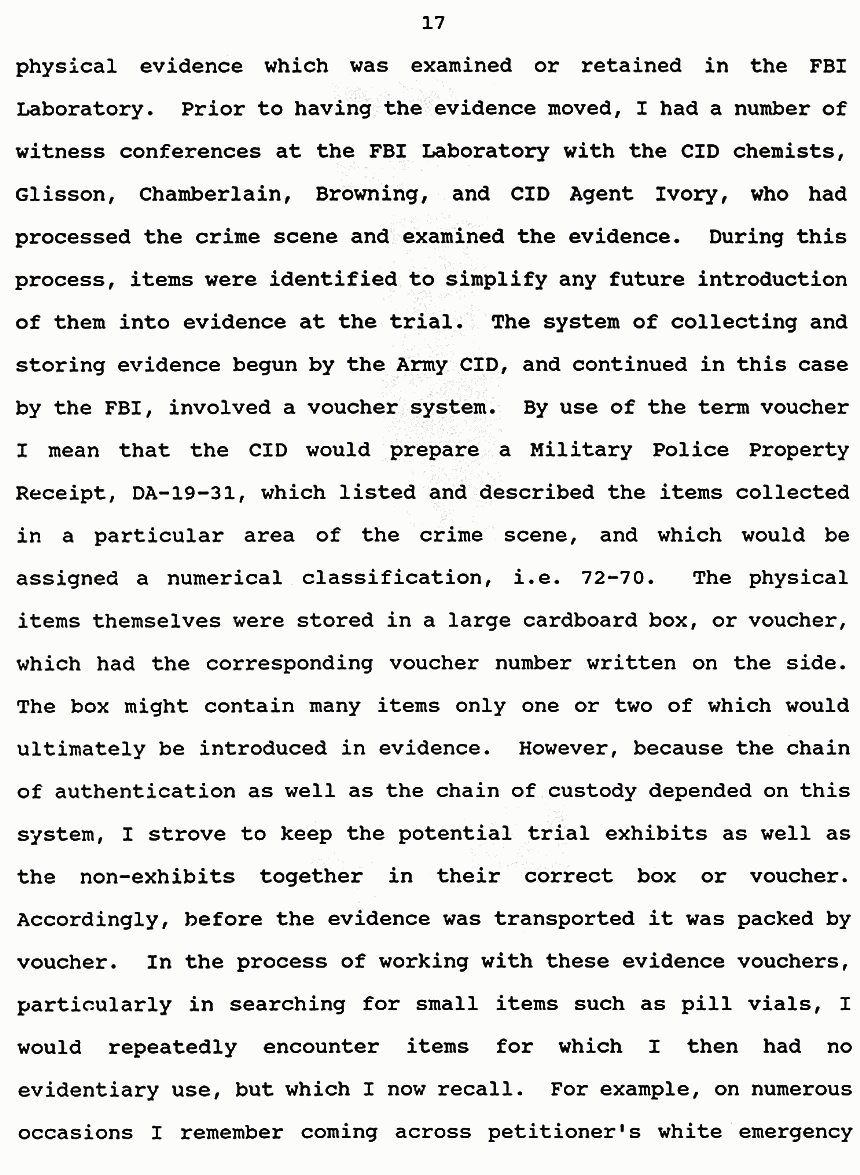
February 19, 1991: Affidavit of Brian Murtagh, page 17 of 37
|
|
February 19, 1991: Affidavit of Brian Murtagh, page 17
Click icon to expand and reduce original image. Drag the expanded image to move it.
|
|
|
|
17
physical evidence which was examined or retained in the FBI
Laboratory. Prior to having the evidence moved, I had a number of
witness conferences at the FBI laboratory with the CID chemists,
Glisson, Chamberlain, Browning, and CID Agent Ivory, who had
processed the crime scene and examined the evidence. During this
process, items were identified to simplify any future introduction
of them into evidence at the trial. The system of collecting and
storing evidence begun by the Army CID, and continued in this case
by the FBI, involved a voucher system. By use of the term voucher
I mean that the CID would prepare a Military Police Property
Receipt, DA-19-31, which listed and described the items collected
in a particular area of the crime scene, and which would be
assigned aa numerical classification, i.e. 72-70. The physical
items themselves were stored in a large cardboard box, or voucher,
which had the corresponding voucher number written on the side.
The box might contain many items only one or two of which would
ultimately be introduced in evidence. However, because the chain
of authentication as well as the chain of custody depended on this
system, I strove to keep the potential trial exhibits as well as
the non-exhibits together in their correct box or voucher.
Accordingly, before the evidence was transported it was packed by
voucher. In the process of working with these evidence vouchers,
particularly in searching for small items such as pill vials, I
would repeatedly encounter items for which I then had no
evidentiary use, but which I now recall. For example, on numerous
occasions I remember coming across petitioner's white emergency
|
|
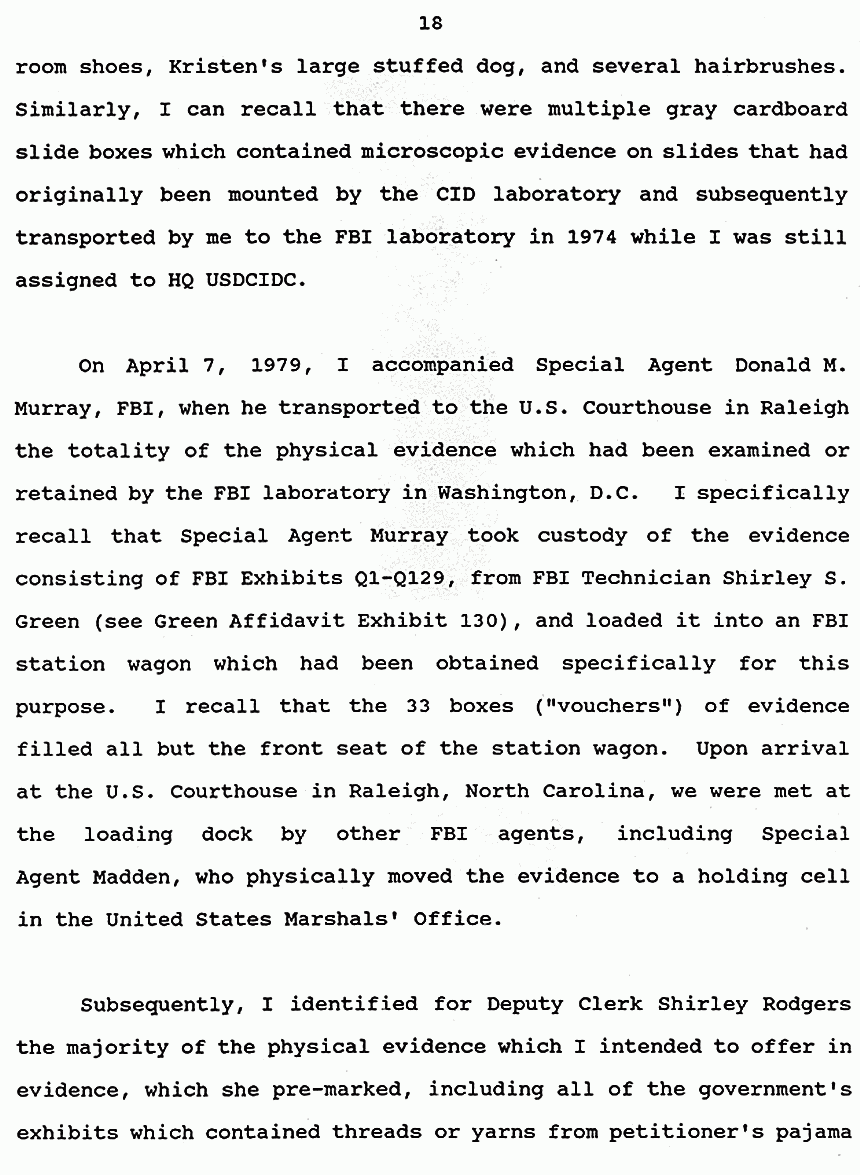
February 19, 1991: Affidavit of Brian Murtagh, page 18 of 37
|
|
February 19, 1991: Affidavit of Brian Murtagh, page 18
Click icon to expand and reduce original image. Drag the expanded image to move it.
|
|
|
|
18
room shoes, Kristen's large stuffed dog, and several hairbrushes.
Similarly, I can recall that there were multiple gray cardboard
slide boxes which contained.microscopic evidence on slides that had
originally been mounted by the CID laboratory and subsequently
transported by me to the FBI laboratory in 1974 while I was still
assigned to HQ USDCIDC.
On April 7, 1979, I accompanied Special Agent Donald M.
Murray, FBI, when he transported to the U.S. Courthouse in Raleigh
the totality of the physical evidence which had been examined or
retained by the FBI laboratory in Washington, D.C. I specifically
recall that Special Agent Murray took custody of the evidence
consisting of FBI Exhibits Q1-Q129, from FBI Technician Shirley S.
Green (see Green Affidavit Exhibit 130), and loaded it into an FBI
station wagon which had been obtained specifically for this
purpose. I recall that the 33 boxes ("vouchers") of evidence
filled all but the front seat of the station wagon. Upon arrival
at the U.S. Courthouse in Raleigh, North Carolina, we were met at
the loading dock by other FBI agents, including Special
Agent Madden, who physically moved the evidence to a holding cell
in the United States Marshals' Office.
Subsequently, I identified for Deputy Clerk Shirley Rodgers
the majority of the physical evidence which I intended to offer in
evidence, which she pre-marked, including all of the government's
exhibits which contained threads or yarns from petitioner's pajama
|
|
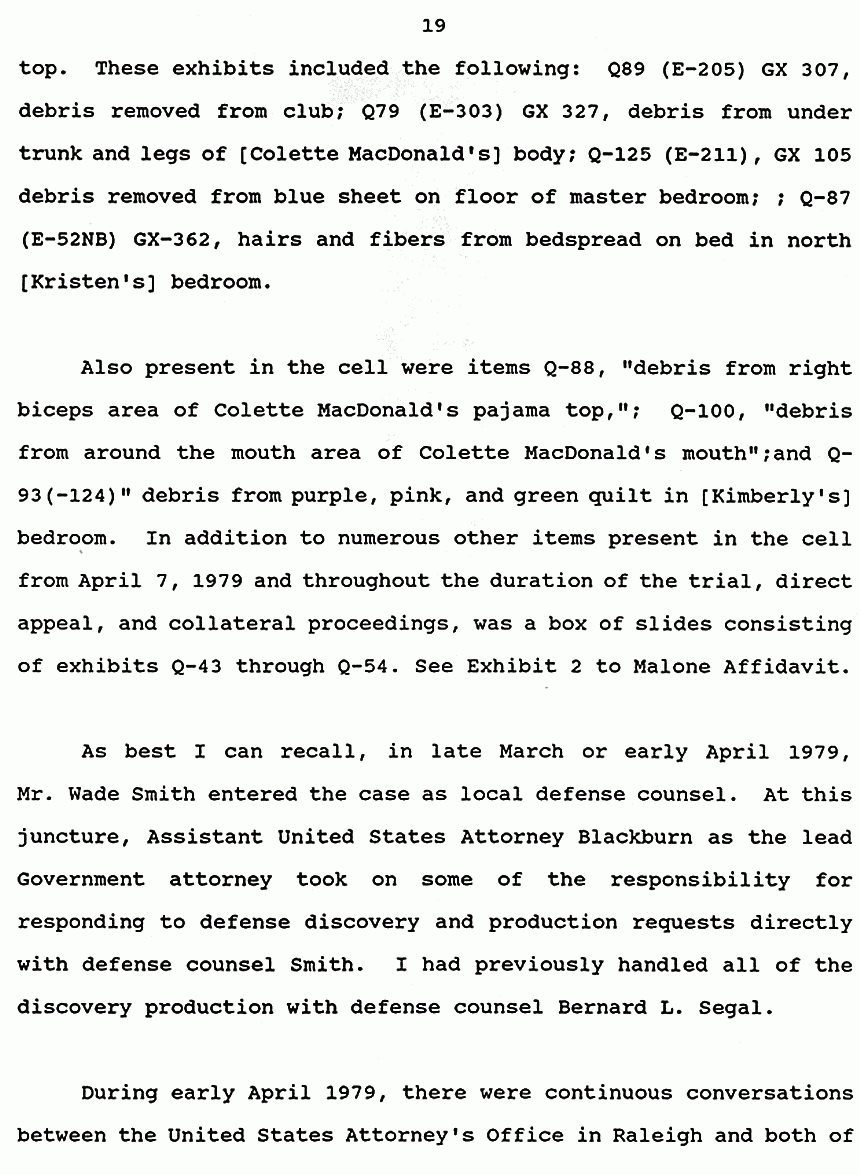
February 19, 1991: Affidavit of Brian Murtagh, page 19 of 37
|
|
February 19, 1991: Affidavit of Brian Murtagh, page 19
Click icon to expand and reduce original image. Drag the expanded image to move it.
|
|
|
|
19
top. These exhibits included the following: Q89 (E-205) GX 307,
debris removed from club; Q79 (E-303) GX 327, debris from under
trunk and legs of [Colette MacDonald's] body; Q-125 (E-211), GX 105
debris removed from blue sheet on floor of master bedroom; ; Q-87
(E-52NB) GX-362, hairs and fibers from bedspread on bed in north
[Kristen's] bedroom.
Also present in the cell were items Q-88, "debris from right
biceps area of Colette MacDonald's pajama top,"; Q-100, "debris
from around the mouth area of Colette MacDonald's mouth";and Q-
93(-124)" debris from purple, pink, and green quilt in [Kimberly's]
bedroom. In addition to numerous other items present in the cell
from April 7, 1979 and throughout the duration of the trial, direct
appeal, and collateral proceedings, was a box of slides consisting
of exhibits Q-43 through Q-54. See Exhibit 2 to Malone Affidavit.
As best I can recall, in late March or early April 1979,
Mr. Wade Smith entered the case as local defense counsel. At this
juncture, Assistant United States Attorney Blackburn as the lead
Government attorney took on some of the responsibility for
responding to defense discovery and production requests directly
with defense counsel Smith. I had previously handled all of the
discovery production with defense counsel Bernard L. Segal.
During early April 1979, there were continuous conversations
between the United States Attorney's Office in Raleigh and both of
|
|
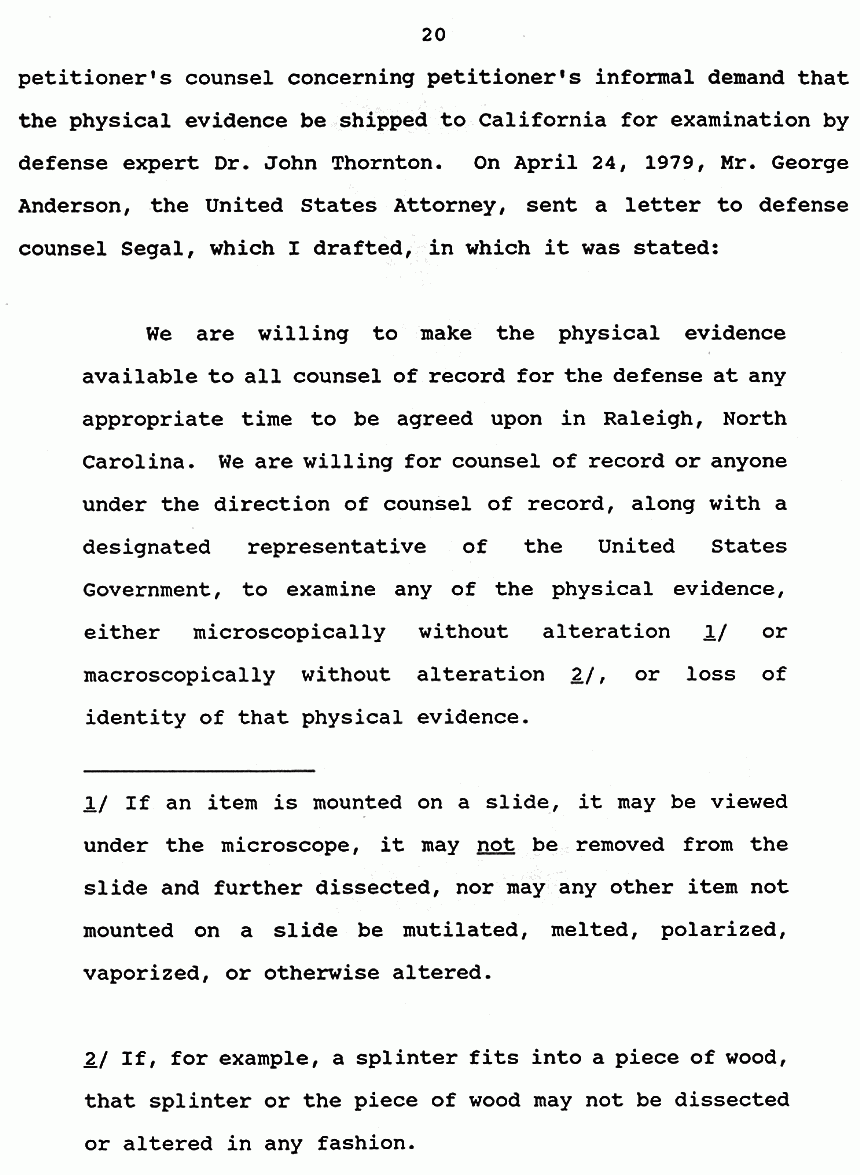
February 19, 1991: Affidavit of Brian Murtagh, page 20 of 37
|
|
February 19, 1991: Affidavit of Brian Murtagh, page 20
Click icon to expand and reduce original image. Drag the expanded image to move it.
|
|
|
|
20
petitioner's counsel concerning petitioner's informal demand that
the physical evidence be shipped to California for examination by
defense expert Dr. John Thornton. On April 24, 1979, Mr. George
Anderson, the United States Attorney, sent a letter to defense
counsel Segal, which I drafted, in which it was stated:
We are willing to make the physical evidence
available to all counsel of record for the defense at any
appropriate time to be agreed upon in Raleigh, North
Carolina. We are willing for counsel of record or anyone
under the direction of counsel of record, along with a
designated representative of the United States
Government, to examine any of the physical evidence,
either microscopical1y without alteration l/ or
macroscopically without alteration 2/, or loss of
identity of that physical evidence.
___________________
l If an item is mounted on a slide, it may be viewed
under the microscope, it may not be removed from the
slide and further dissected, nor may any other item not
mounted on a slide be mutilated, melted, polarized,
vaporized, or otherwise altered.
2/ If, for example, a splinter fits into a piece of wood,
that splinter or the piece of wood may not be dissected
or altered in any fashion.
|
|
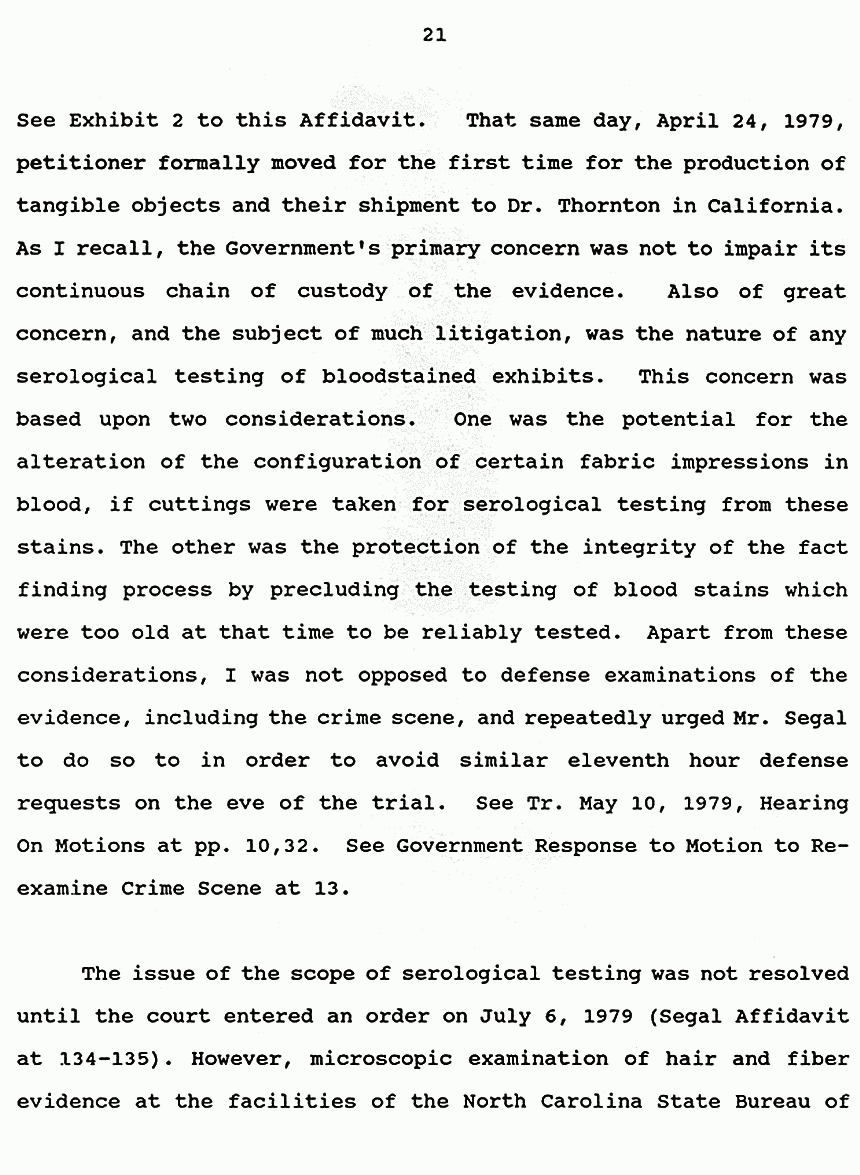
February 19, 1991: Affidavit of Brian Murtagh, page 21 of 37
|
|
February 19, 1991: Affidavit of Brian Murtagh, page 21
Click icon to expand and reduce original image. Drag the expanded image to move it.
|
|
|
|
21
See Exhibit 2 to this Affidavit. That same day, April 24, 1979,
petitioner formally moved for the first time for the production of
tangible objects and their shipment to Dr. Thornton in California.
As I recall, the Government's primary concern was not to impair its
continuous chain of custody of the evidence. Also of great
concern, and the subject of much litigation, was the nature of any
serological testing of bloodstained exhibits. This concern was
based upon two considerations. One was the potential for the
alteration of the configuration of certain fabric impressions in
blood, if cuttings were taken for serological testing from these
stains. The other was the protection of the integrity of the fact
finding process by precluding the testing of blood stains which
were too old at that time to be reliably tested. Apart from these
considerations, I was not opposed to defense examinations of the
evidence, including the crime scene, and repeatedly urged Mr. Segal
to do so to in order to avoid similar eleventh hour defense
requests on the eve of the trial. See Tr. May 10, 1979, Hearing
On Motions at pp. 10,32. See Government Response to Motion to Re-
examine Crime Scene at 13.
The issue of the scope of serological testing was not resolved
until the court entered an order on July 6, 1979 (Segal Affidavit
at 134-135). However, microscopic examination of hair and fiber
evidence at the facilities of the North Carolina State Bureau of
|
|
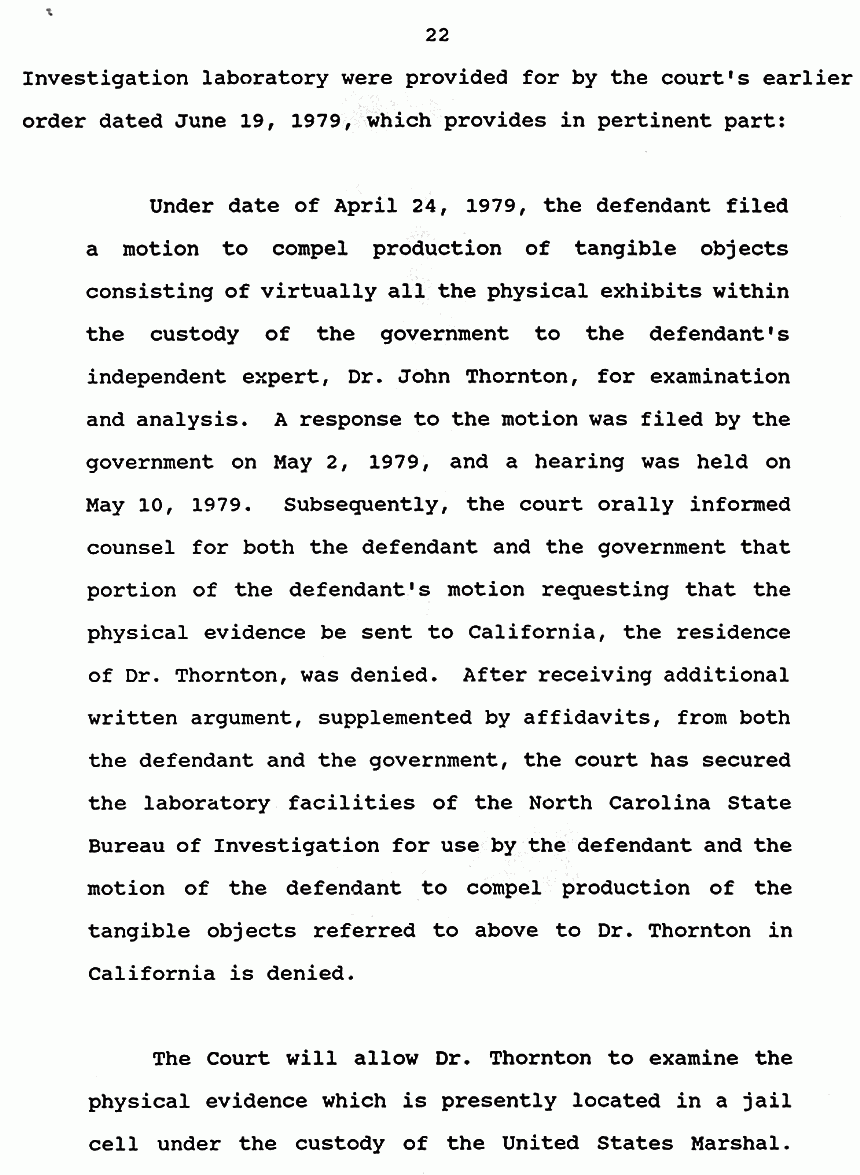
February 19, 1991: Affidavit of Brian Murtagh, page 22 of 37
|
|
February 19, 1991: Affidavit of Brian Murtagh, page 22
Click icon to expand and reduce original image. Drag the expanded image to move it.
|
|
|
|
22
Investigation laboratory were provided for by the court's earlier
order dated June 19, 1979, which provides in pertinent part:
Under date of April 24, 1979, the defendant filed
a motion to compel production of tangible objects
consisting of virtually all the physical exhibits within
the custody of the government to the defendant's
independent expert, Dr. John Thornton, for examination
and analysis. A response to the motion was filed by the
government on May 2, 1979, and a hearing was held on
May 10, 1979. Subsequently, the court orally informed
counsel for both the defendant and the government that
portion of the defendant's motion requesting that the
physical evidence be sent to California, the residence
of Dr. Thornton, was denied. After receiving additional
written argument, supplemented by affidavits, from both
the defendant and the government, the court has secured
the laboratory facilities of the North Carolina State
Bureau of Investigation for use by the defendant and the
motion of the defendant to compel production of the
tangible objects referred to above to Dr. Thornton in
California is denied.
The Court will allow Dr. Thornton to examine the
physical evidence which is presently located in a jail
cell under the custody of the United States Marshal.
|
|
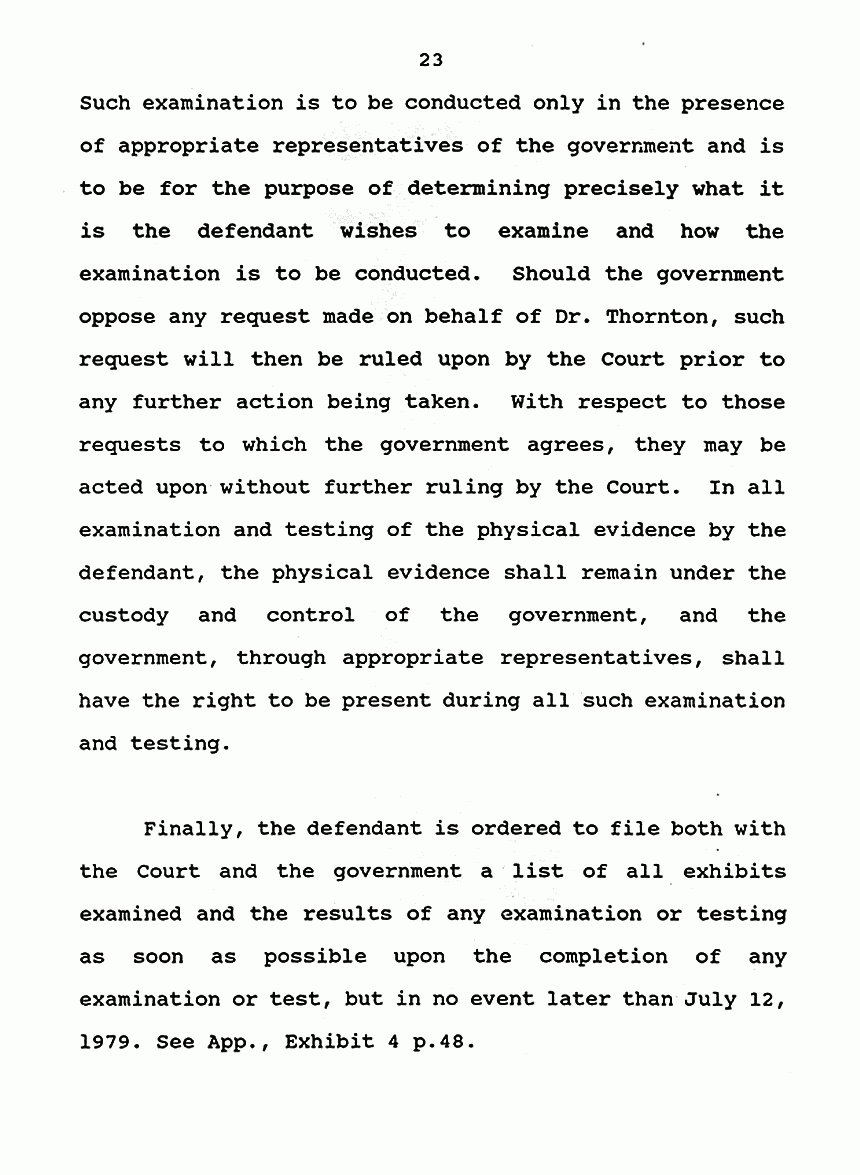
February 19, 1991: Affidavit of Brian Murtagh, page 23 of 37
|
|
February 19, 1991: Affidavit of Brian Murtagh, page 23
Click icon to expand and reduce original image. Drag the expanded image to move it.
|
|
|
|
23
Such examination is to be conducted only in the presence
of appropriate representatives of the government and is
to be for the purpose of determining precisely what it
is the defendant wishes to examine and how the
examination is to be conducted. Should the government
oppose any request made on behalf of Dr. Thornton, such
request will then be ruled upon by the Court prior to
any further action being taken. With respect to those
requests to which the government agrees, they may be
acted upon without further ruling by the Court. In all
examination and testing of the physical evidence by the
defendant, the physical evidence shall remain under the
custody and control of the government, and the
government, through appropriate representatives, shall
have the right to be present during all such examination
and testing.
Finally, the defendant is ordered to file both with
the Court and the government a list of all exhibits
examined and the results of any examination or testing
as soon as possible upon the completion of any
examination or test, but in no event later than July 12,
1979. See App., Exhibit 4 p.48.
|
|
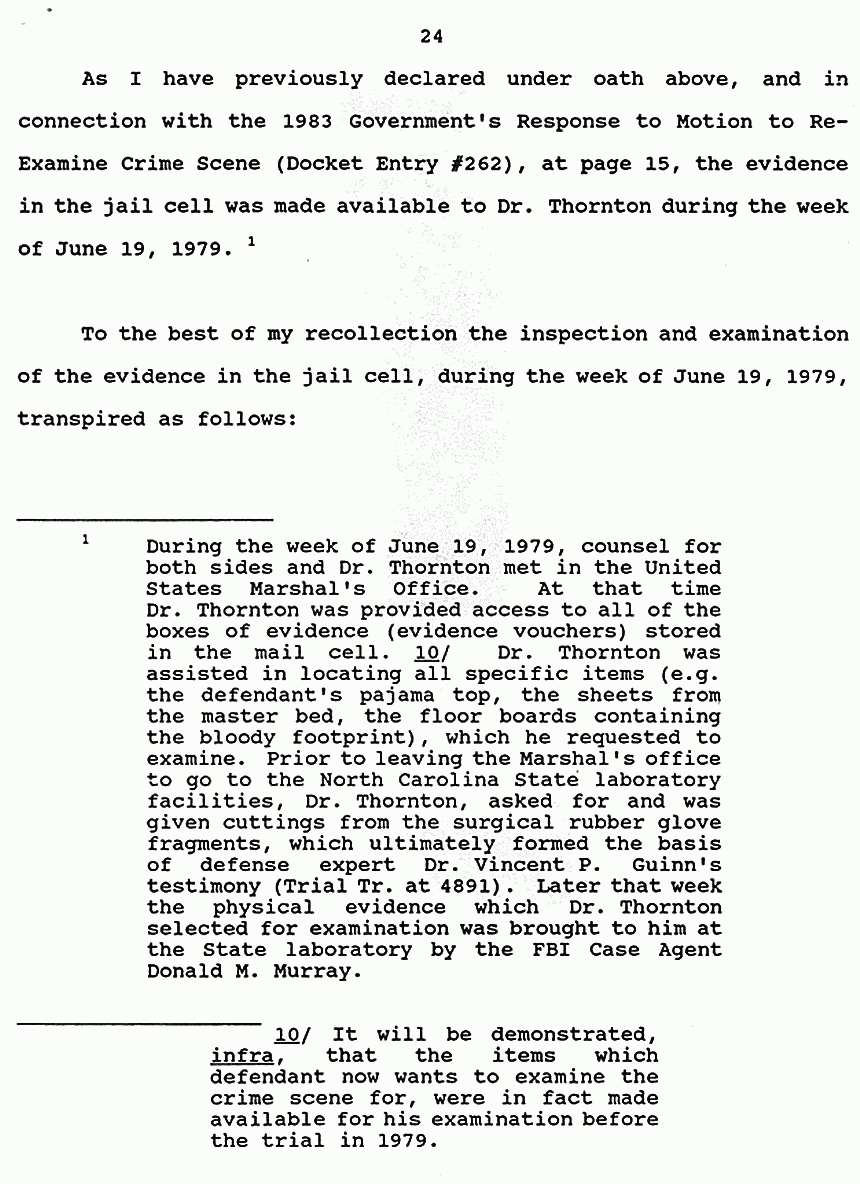
February 19, 1991: Affidavit of Brian Murtagh, page 24 of 37
|
|
February 19, 1991: Affidavit of Brian Murtagh, page 24
Click icon to expand and reduce original image. Drag the expanded image to move it.
|
|
|
|
24
As I have previously declared under oath above, and in
connection with the 1983 Government's Response to Motion to Re-
Examine Crime Scene (Docket Entry #262), at page 15, the evidence
in the jail cell was made available to Dr. Thornton during the week
of June 19, 1979. 1
To the best of my recollection the inspection and examination
of the evidence in the jail cell, during the week of June 19, 1979,
transpired as follows:
___________________
|
1 |
During the week of June 19, 1979, counsel for
both sides and Dr. Thornton met in the United
States Marshal's Office. At that time
Dr. Thornton was provided access to all of the
boxes of evidence (evidence vouchers) stored
in the mail cell. 10/ Dr. Thornton was
assisted in locating all specific items (e.g.
the defendant's pajama top, the sheets from
the master bed, the floor boards containing
the bloody footprint), which he requested to
examine. Prior to leaving the Marshal's office
to go to the North Carolina State laboratory
facilities, Dr. Thornton, asked for and was
given cuttings from the surgical rubber glove
fragments, which ultimately formed the basis
of defense expert Dr. Vincent P. Guinn's
testimony (Trial Tr. at 4891). Later that week
the physical evidence which Dr. Thornton
selected for examination was brought to him
at the State laboratory by the FBI Case Agent
Donald M. Murray.
______________
10/ It will be demonstrated,
infra, that the items which
defendant now wants to examine the
crime scene for, were in fact made
available for his examination before
the trial in 1979.
|
|
|
|
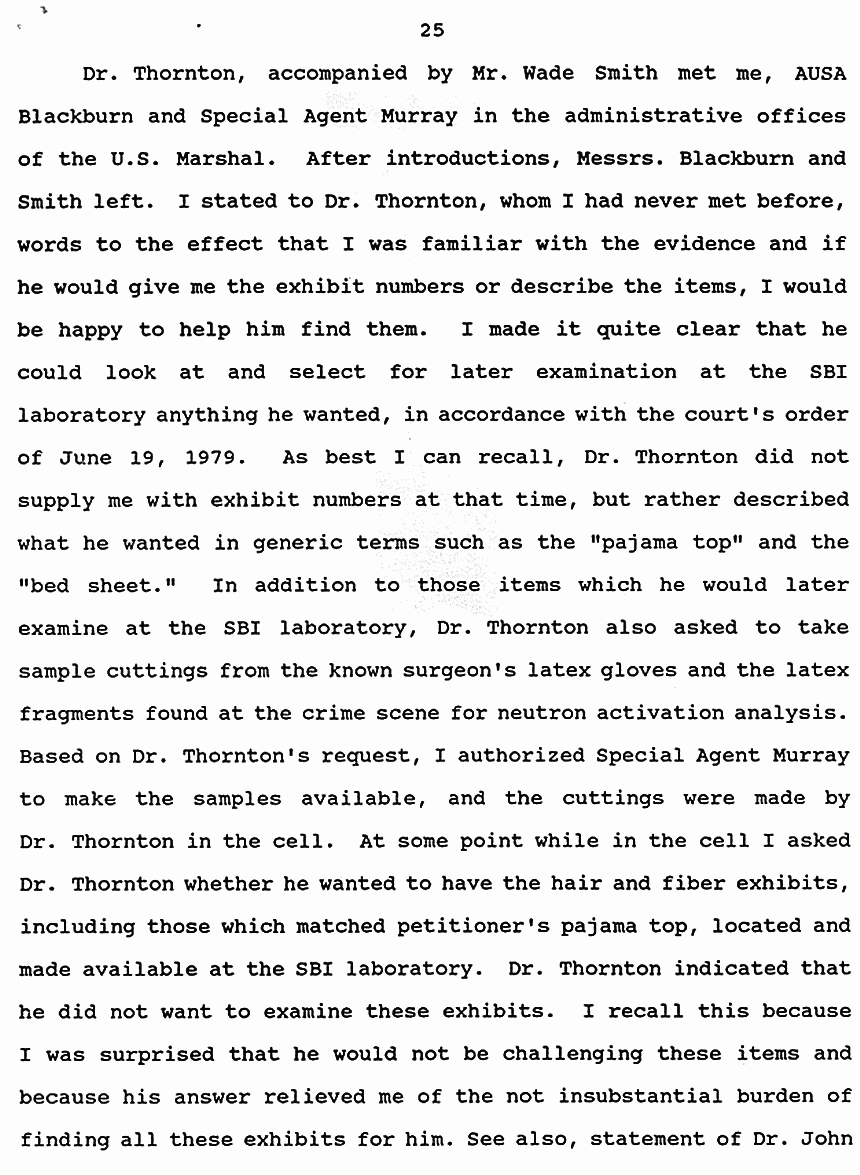
February 19, 1991: Affidavit of Brian Murtagh, page 25 of 37
|
|
February 19, 1991: Affidavit of Brian Murtagh, page 25
Click icon to expand and reduce original image. Drag the expanded image to move it.
|
|
|
|
25
Dr. Thornton, accompanied by Mr. Wade Smith met me, AUSA
Blackburn and Special Agent Murray in the administrative offices
of the U.S. Marshal. After introductions, Messrs. Blackburn and
Smith left. I stated to Dr. Thornton, whom I had never met before,
words to the effect that I was familiar with the evidence and if
he would give me the exhibit numbers or describe the items, I would
be happy to help him find them. I made it quite clear that he
could look at and select for later examination at the SBI
laboratory anything he wanted, in accordance with the court's order
of June 19, 1979. As best I can recall, Dr. Thornton did not
supply me with exhibit numbers at that time, but rather described
what he wanted in generic terms such as the "pajama top" and the
"bed sheet." In addition to those items which he would later
examine at the SBI laboratory, Dr. Thornton also asked to take
sample cuttings from the known surgeon's latex gloves and the latex
fragments found at the crime scene for neutron activation analysis.
Based on Dr. Thornton's request, I authorized Special Agent Murray
to make the samples available, and the cuttings were made by
Dr. Thornton in the cell. At some point while in the cell I asked
Dr. Thornton whether he wanted to have the hair and fiber exhibits,
including those which matched petitioner's pajama top, located and
made available at the SBI laboratory. Dr. Thornton indicated that
he did not want to examine these exhibits. I recall this because
I was surprised that he would not be challenging these items and
because his answer relieved me of the not insubstantial burden of
finding all these exhibits for him. See also, statement of Dr. John
|
|
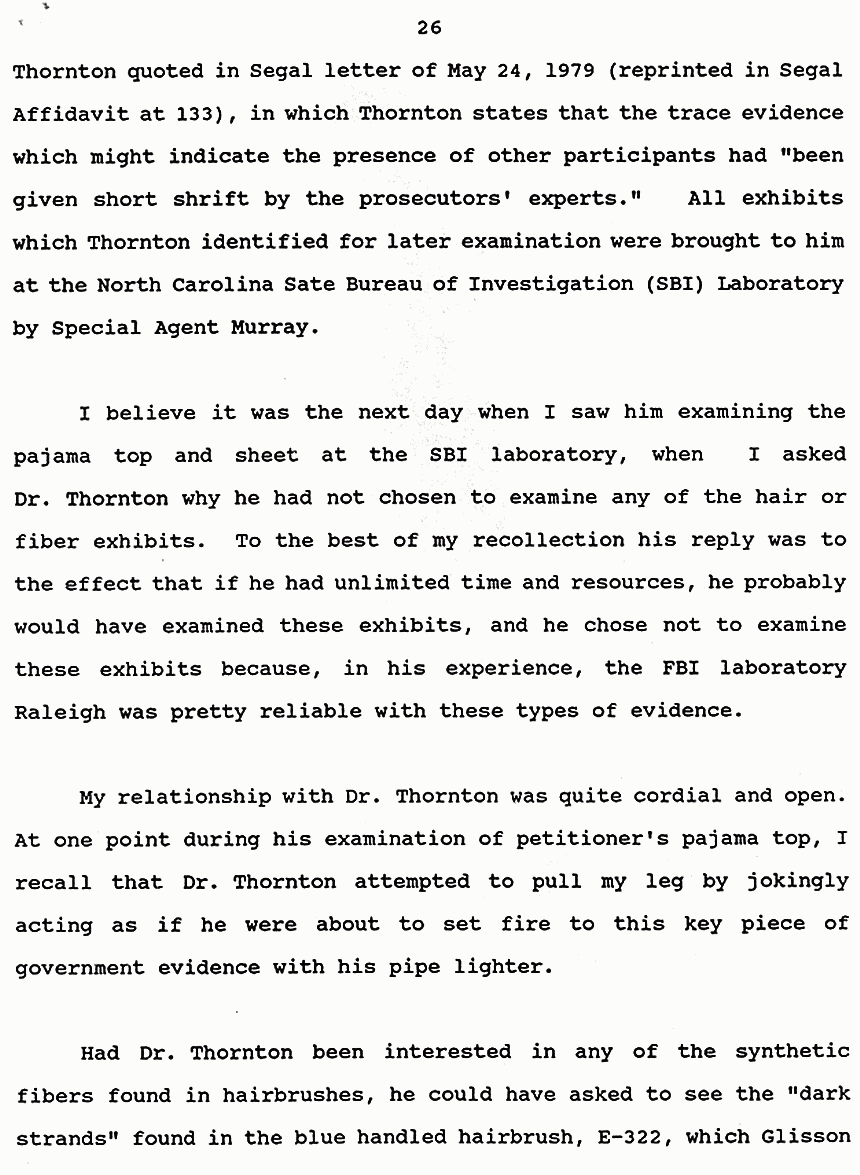
February 19, 1991: Affidavit of Brian Murtagh, page 26 of 37
|
|
February 19, 1991: Affidavit of Brian Murtagh, page 26
Click icon to expand and reduce original image. Drag the expanded image to move it.
|
|
|
|
26
Thornton quoted in Segal letter of May 24, 1979 (reprinted in Segal
Affidavit.at 133), in which Thornton states that the trace evidence
which might indicate the presence of other participants had "been
given short shrift by the prosecutors' experts." All exhibits
which Thornton identified for later examination were brought to him
at the North Carolina Sate Bureau of Investigation (SBI) Laboratory
by Special Agent Murray.
I believe it was the next day when I saw him examining the
pajama top and sheet at the SBI laboratory, when I asked
Dr. Thornton why he had not chosen to examine any of the hair or
fiber exhibits. To the best of my recollection his reply was to
the effect that if he had unlimited time and resources, he probably
would have examined these exhibits, and he chose not to examine
these exhibits because, in his experience, the FBI laboratory
Raleigh was pretty reliable with these types of evidence.
My relationship with Dr. Thornton was quite cordial and open.
At one point during his examination of petitioner's pajama top, I
recall that Dr. Thornton attempted to pull my leg by jokingly
acting as if he were about to set fire to this key piece of
government evidence with his pipe lighter.
Had Dr. Thornton been interested in any of the synthetic
fibers found in hairbrushes, he could have asked to see the "dark
strands" found in the blue handled hairbrush, E-322, which Glisson
|
|
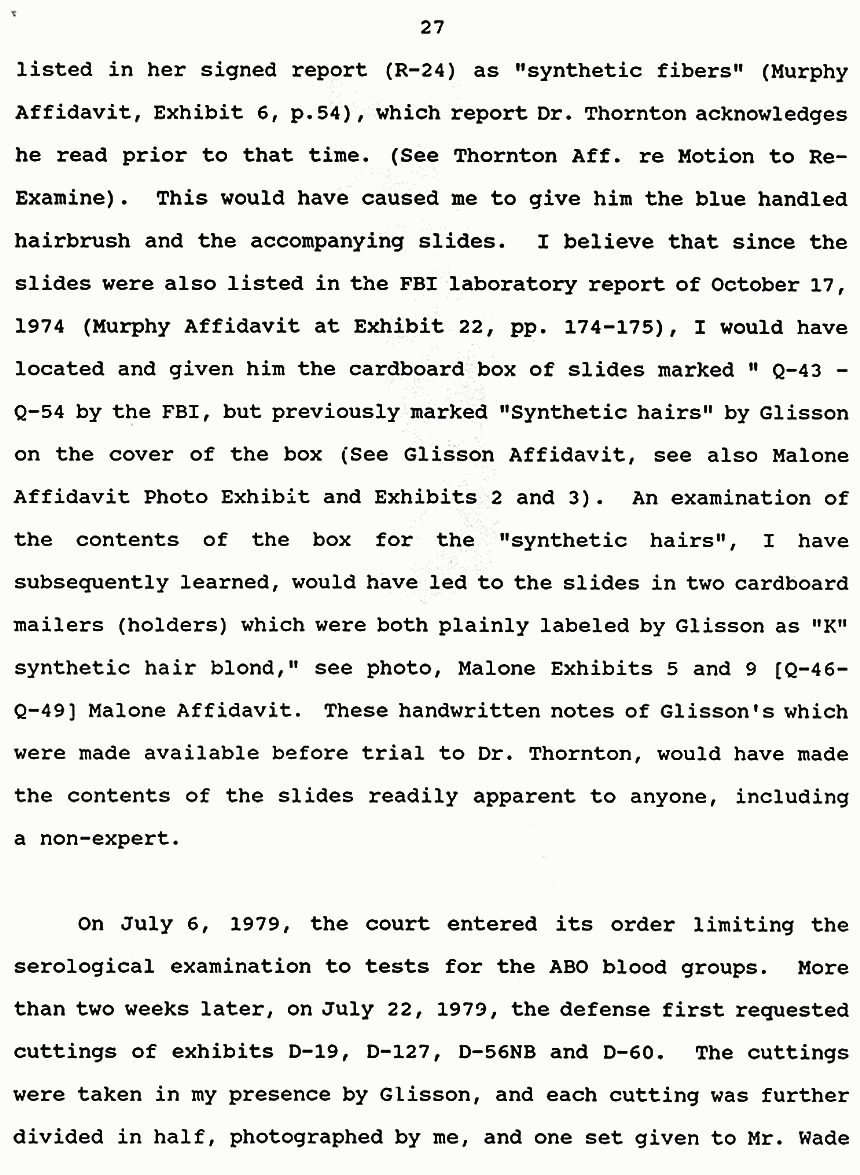
February 19, 1991: Affidavit of Brian Murtagh, page 27 of 37
|
|
February 19, 1991: Affidavit of Brian Murtagh, page 27
Click icon to expand and reduce original image. Drag the expanded image to move it.
|
|
|
|
27
listed in her signed report (R-24) as "synthetic fibers" (Murphy
Affidavit, Exhibit 6, p.54), which report Dr. Thornton acknowledges
he read prior to that time. (See Thornton Aff. re Motion to Re-
Examine). This would have caused me to give him the blue handled
hairbrush and the accompanying slides. I believe that since the
slides were also listed in the FBI laboratory report of October 17,
1974 (Murphy Affidavit at Exhibit 22, pp. 174-175), I would have
located and given him the cardboard box of slides marked " Q-43 -
Q-54 by the FBI, but previously marked "Synthetic hairs" by Glisson
on the cover of the box (See Glisson Affidavit, see also Malone
Affidavit Photo Exhibit and Exhibits 2 and 3). An examination of
the contents of the box for the "synthetic hairs", I have
subsequently learned, would have led to the slides in two cardboard
mailers (holders) which were both plainly labeled by Glisson as "K"
synthetic hair blond," see photo, Malone Exhibits 5 and 9 [Q-46-
Q-49] Malone Affidavit. These handwritten notes of Glisson's which
were made available before trial to Dr. Thornton, would have made
the contents of the slides readily apparent to anyone, including
a non-expert.
On July 6, 1979, the court entered its order limiting the
serological examination to tests for the ABO blood groups. More
than two weeks later, on July 22, 1979, the defense first requested
cuttings of exhibits D-l9, D-127, D-56NB and D-60. The cuttings
were taken in my presence by Glisson, and each cutting was further
divided in half, photographed by me, and one set given to Mr. Wade
|
|
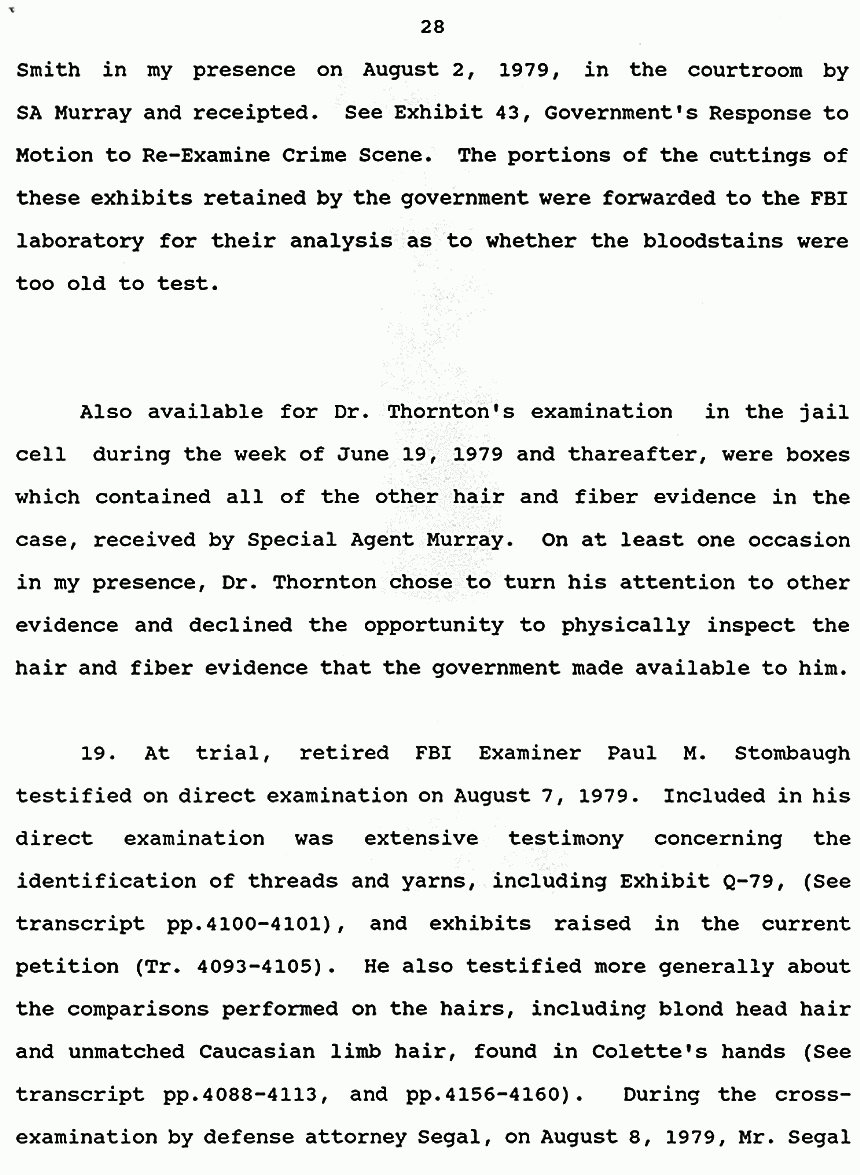
February 19, 1991: Affidavit of Brian Murtagh, page 28 of 37
|
|
February 19, 1991: Affidavit of Brian Murtagh, page 28
Click icon to expand and reduce original image. Drag the expanded image to move it.
|
|
|
|
28
Smith in my presence on August 2, 1979, in the courtroom by
SA Murray and receipted. See Exhibit 43, Government's Response to
Motion to Re-Examine Crime Scene. The portions of the cuttings of
these exhibits retained by the government were forwarded to the FBI
laboratory for their analysis as to whether the bloodstains were
too old to test.
Also available for Dr. Thornton's examination in the jail
cell during the week of June 19, 1979 and thereafter, were boxes
which contained all of the other hair and fiber evidence in the
case, received by Special Agent Murray. On at least one occasion
in my presence, Dr. Thornton chose to turn his attention to other
evidence and declined the opportunity to physically inspect the
hair and fiber evidence that the government made available to him.
19. At trial, retired FBI Examiner Paul M. Stombaugh
testified on direct examination on August 7, 1979. Included in his
direct examination was extensive testimony concerning the
identification of threads and yarns, including Exhibit Q-79, (See
transcript pp.4100-4101), and exhibits raised in the current
petition (Tr. 4093-4105). He also testified more generally about
the comparisons performed on the hairs, including blond head hair
and unmatched Caucasian limb hair, found in Colette's hands (See
transcript pp.4088-4113, and pp.4l56-4160). During the cross-
examination by defense attorney Segal, on August 8, 1979, Mr. Segal
|
|
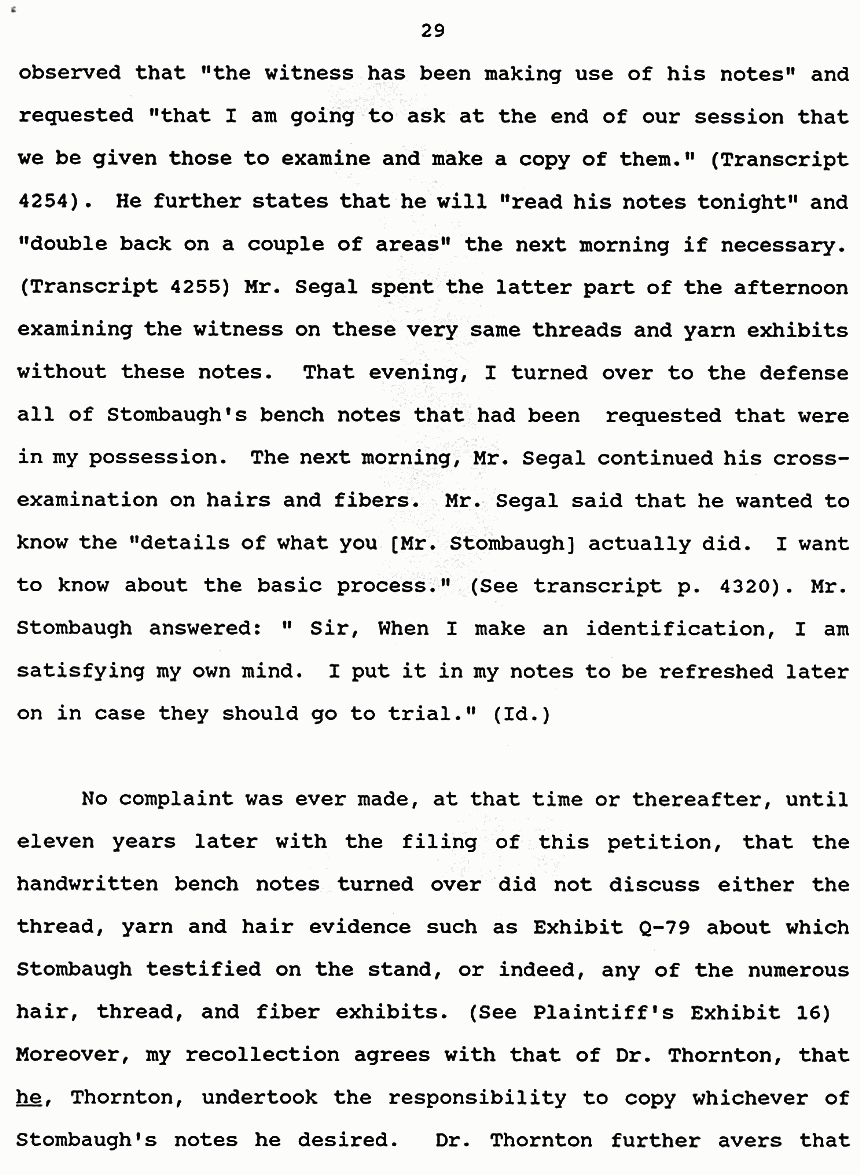
February 19, 1991: Affidavit of Brian Murtagh, page 29 of 37
|
|
February 19, 1991: Affidavit of Brian Murtagh, page 29
Click icon to expand and reduce original image. Drag the expanded image to move it.
|
|
|
|
29
observed that "the witness has been making use of his notes" and
requested "that I am going to ask at the end of our session that
we be given those to examine and make a copy of them." (Transcript
4254). He further states that he will "read his notes tonight" and
"double back on a couple of areas" the next morning if necessary.
(Transcript 4255) Mr. Segal spent the latter part of the afternoon
examining the witness on these very same threads and yarn exhibits
without these notes. That evening, I turned over to the defense
all of Stombaugh's bench notes that had been requested that were
in my possession. The next morning, Mr. Segal continued his cross-
examination on hairs and fibers. Mr. Segal said that he wanted to
know the "details of what you [Mr. Stombaugh] actually did. I want
to know about the basic prooess." (See transcript p. 4320). Mr.
Stombaugh answered: " Sir, When I make an identification, I am
satisfying my own mind. I put it in my notes to be refreshed later
on in case they should go to trial." (Id.)
No complaint was ever made, at that time or thereafter, until
eleven years later with the filing of this petition, that the
handwritten bench notes turned over did not discuss either the
thread, yarn and hair evidence such as Exhibit Q-79 about which
Stombaugh testified on the stand, or indeed, any of the numerous
hair, thread, and fiber exhibits. (See Plaintiff's Exhibit 16)
Moreover, my recollection agrees with that of Dr. Thornton, that
hg, Thornton, undertook the responsibility to copy whichever of
Stombaugh's notes he desired. Dr. Thornton further avers that
|
|
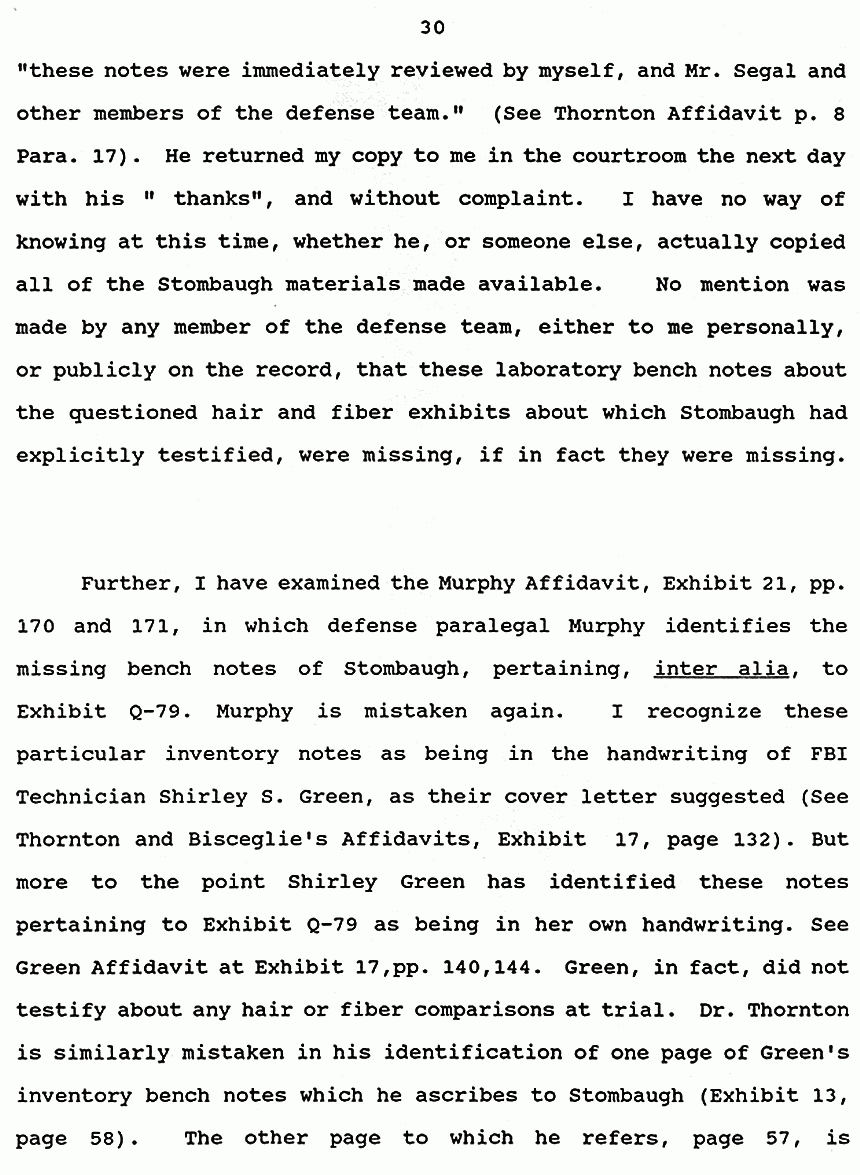
February 19, 1991: Affidavit of Brian Murtagh, page 30 of 37
|
|
February 19, 1991: Affidavit of Brian Murtagh, page 30
Click icon to expand and reduce original image. Drag the expanded image to move it.
|
|
|
|
30
"these notes were immediately reviewed by myself, and Mr. Segal and
other members of the defense team." (See Thornton Affidavit p. 8
Para. 17). He returned my copy to me in the courtroom the next day
with his " thanks", and without complaint. I have no way of
knowing at this time, whether he, or someone else, actually copied
all of the Stombaugh materials made available. No mention was
made by any member of the defense team, either to me personally,
or publicly on the record, that these laboratory bench notes about
the questioned hair and fiber exhibits about which Stombaugh had
explicitly testified, were missing, if in fact they were missing.
Further, I have examined the.Murphy Affidavit, Exhibit 21, pp.
170 and 171, in which defense paralegal Murphy identifies the
missing' bench notes of Stombaugh, pertaining, inter alia, to
Exhibit Q-79. Murphy is mistaken again. I recognize these
particular inventory notes as being in the handwriting of FBI
Technician Shirley S. Green, as their cover letter suggested (See
Thornton and Bisceglie's Affidavits, Exhibit 17, page 132). But
more to the point Shirley Green has identified these notes
pertaining to Exhibit Q-79 as being in her own handwriting. See
Green Affidavit at Exhibit 17,pp. 140,144. Green, in fact, did not
testify about any hair or fiber comparisons at trial. Dr. Thornton
is similarly mistaken in his identification of one page of Green's
inventory bench notes which he ascribes to Stombaugh (Exhibit 13,
page 58). The other page to which he refers, page 57, is
|
|
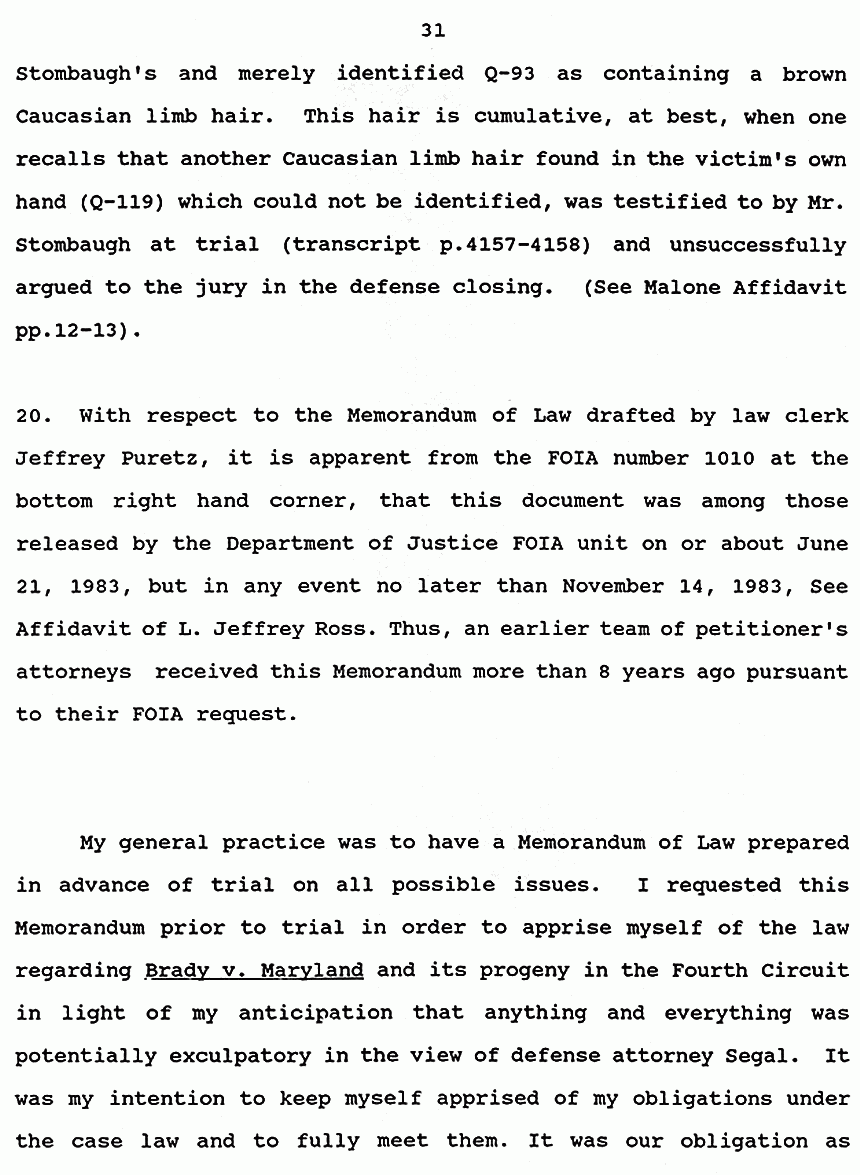
February 19, 1991: Affidavit of Brian Murtagh, page 31 of 37
|
|
February 19, 1991: Affidavit of Brian Murtagh, page 31
Click icon to expand and reduce original image. Drag the expanded image to move it.
|
|
|
|
31
Stombaugh's and merely identified Q-93 as containing a brown
Caucasian limb hair. This hair is cumulative, at best, when one
recalls that another Caucasian limb hair found in the victim's own
hand (Q-119) which could not be identified, was testified to by Mr.
Stombaugh at trial (transcript p.4l57-4158) and unsuccessfully
argued to the jury in the defense closing. (See Malone Affidavit
pp.12-13).
20. With respect to the Memorandum of Law drafted by law clerk
Jeffrey Puretz, it is apparent from the FOIA number 1010 at the
bottom right hand cmrner, that this document was among those
released by the Department of Justice FOIA unit on or about June
21, 1983, but in any event no later than November 14, 1983, See
Affidavit of L. Jeffrey Ross. Thus, an earlier team of petitioner's
attorneys received this Memorandum more than 8 years ago pursuant
to their FOIA request.
My general practice was to have a Memorandum of Law prepared
in advance of trial on all possible issues. I requested this
Memorandum prior to trial in order to apprise myself of the law
regarding Brady v. Maryland and its progeny in the Fourth Circuit
in light of my anticipation that anything and everything was
potentially exculpatory in the view of defense attorney Segal. It
was my intention to keep myself apprised of my obligations under
the case law and to fully meet them. It was our obligation as
|
|
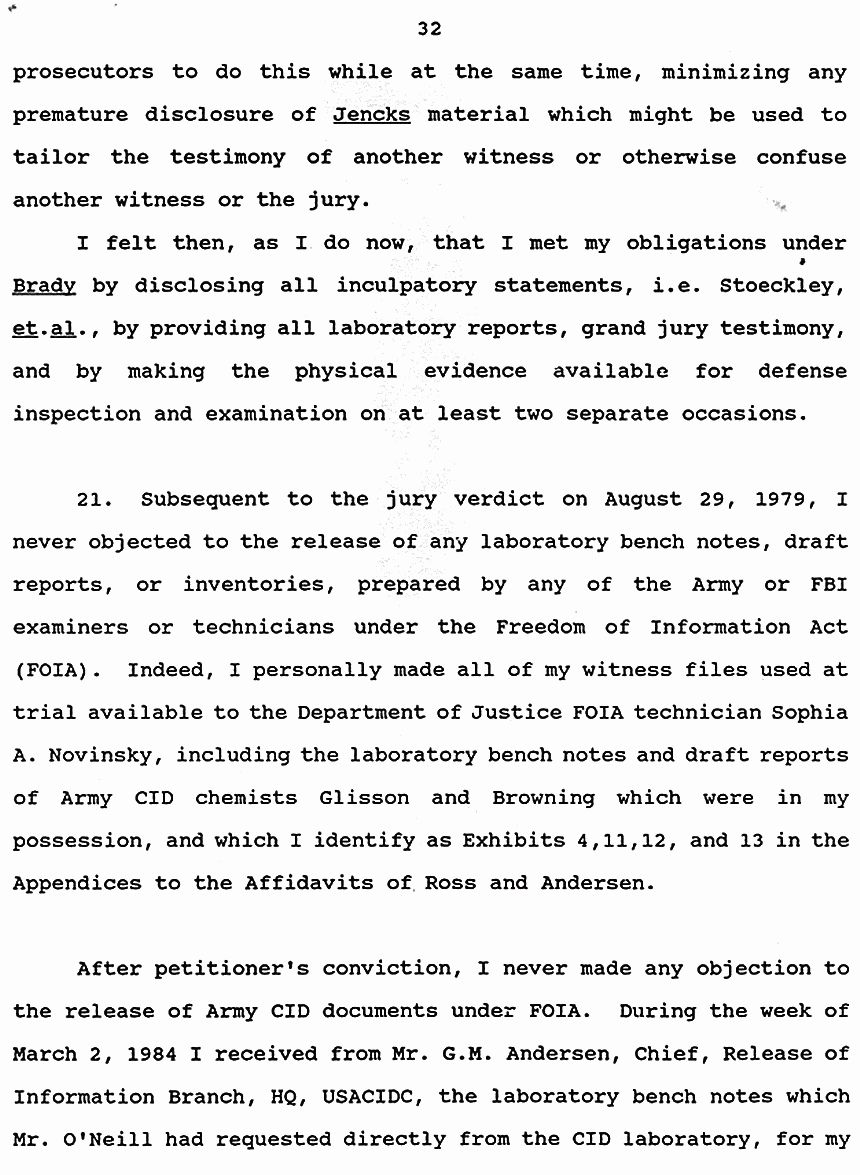
February 19, 1991: Affidavit of Brian Murtagh, page 32 of 37
|
|
February 19, 1991: Affidavit of Brian Murtagh, page 32
Click icon to expand and reduce original image. Drag the expanded image to move it.
|
|
|
|
32
prosecutors to do this while at the same time, mdnimizing any
premature disclosure of Jencks material which might be used to
tailor the testimony of another witness or otherwise confuse
another witness or the jury.
I felt then, as I do now, that I met my obligations under
Brady by disclosing all inculpatory statements, i.e. Stoeckley,
et.al., by providing all laboratory reports, grand jury testimony,
and by making the physical evidence available for defense
inspection and examination on at least two separate occasions.
21. Subsequent to the jury verdict on August 29, 1979, I
never objected to the release of any laboratory bench notes, draft
reports, or inventories, prepared by any of the Army or FBI
examiners or technicians under the Freedom of Information Act
(FOIA). Indeed, I personally made all of my witness files used at
trial available to the Department of Justice FOIA technician Sophia
A. Novinsky, including the laboratory bench notes and draft reports
of Army CID chemists Glisson and Browning which were in my
possession, and.which I identify as Exhibits 4,11,12, and 13 in the
Appendices to the Affidavits of Ross and Andersen.
After petitioner's conviction, I never made any objection to
the release of Army CID documents under FOIA. During the week of
March 2, 1984 I received from Mr. G.M. Andersen, Chief, Release of
Information Branch, HQ, USACIDC, the laboratory bench notes which
Mr. O'Neill had requested directly from the CID laboratory, for my
|
|
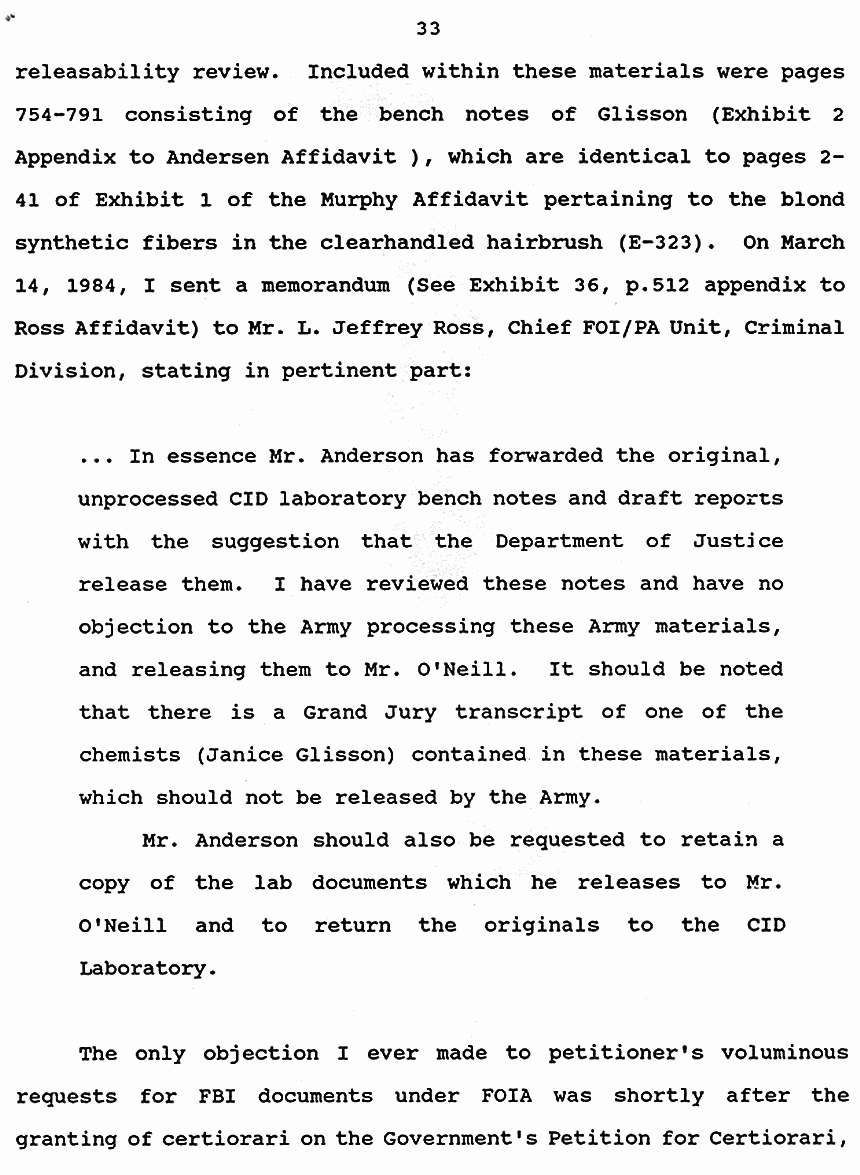
February 19, 1991: Affidavit of Brian Murtagh, page 33 of 37
|
|
February 19, 1991: Affidavit of Brian Murtagh, page 33
Click icon to expand and reduce original image. Drag the expanded image to move it.
|
|
|
|
33
releasability review. Included within these materials were pages
754-791 consisting of the bench notes of Glisson (Exhibit 2
Appendix to Andersen Affidavit ), which are identical to pages 2-
41 of Exhibit 1 of the Murphy Affidavit pertaining to the blond
synthetic fibers in the clearhandled hairbrush (E-323). On March
14, 1984, I sent a memorandum (See Exhibit 36, p.512 appendix to
Ross Affidavit) to Mr. L. Jeffrey Ross, Chief FOI/PA Unit, Criminal
Division, stating in pertinent part:
... In essence Mr. Anderson has forwarded the original,
unprocessed CID laboratory bench notes and draft reports
with the suggestion that the Department of Justice
release them. I have reviewed these notes and have no
objection to the Army processing these Army materials,
and releasing them to Mr. O'Neill. It should be noted
that there is a Grand Jury transcript of one of the
chemists (Janice Glisson) contained in these materials,
which should not be released by the Army.
Mr. Anderson should also be requested to retain a
copy of the lab documents which he releases to Mr.
O'Neill and to return the originals to the CID
Laboratory.
The only objection I ever made to petitioner's voluminous
requests for FBI documents under FOIA was shortly after the
granting of certiorari on the Government's Petition for Certiorari,
|
|
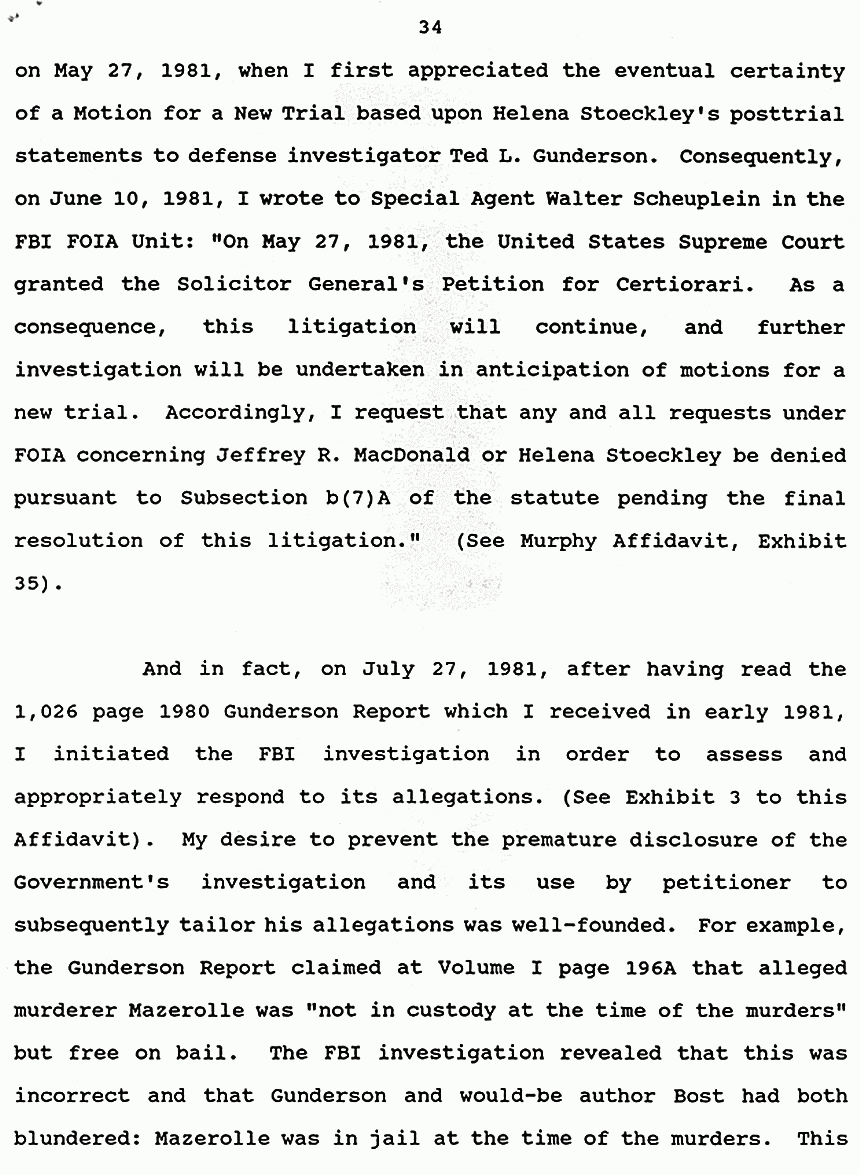
February 19, 1991: Affidavit of Brian Murtagh, page 34 of 37
|
|
February 19, 1991: Affidavit of Brian Murtagh, page 34
Click icon to expand and reduce original image. Drag the expanded image to move it.
|
|
|
|
34
on May 27, 1981, when I first appreciated the eventual certainty
of a Motion for a New Trial based upon Helena Stoeckley's posttrial
statements to defense investigator Ted L. Gunderson. Consequently,
on June 10, 1981, I wrote to Special Agent Walter Scheuplein in the
FBI FOIA Unit: "On May 27, 1981, the United States Supreme Court
granted the Solicitor General's Petition for Certiorari. As a
consequence, this litigation will continue, and further
investigation will be undertaken in anticipation of motions for a
new trial. Accordingly, I request that any and all requests under
FOIA concerning Jeffrey R. MacDonald or Helena Stoeckley be denied
pursuant to Subsection b(7)A of the statute pending the final
resolution of this 1itigation." (See Murphy Affidavit, Exhibit
35).
And in fact, on July 27, 1981, after having read the
1,026 page 1980 Gunderson Report which I received in early 1981,
I initiated the FBI investigation in order to assess and
appropriately respond to its allegations. (See Exhibit 3 to this
Affidavit). My desire to prevent the premature disclosure of the
Government's investigation and its use by petitioner to
subsequently tailor his allegations was we1l-founded. For example,
the Gunderson Report claimed at Volume I page 196A that alleged
murderer Mazerolle was "not in custody at the time of the murders"
but free on bail. The FBI investigation revealed that this was
incorrect and that Gunderson and would-be author Bost had both
blundered: Mazerolle was in jail at the time of the murders. This
|
|
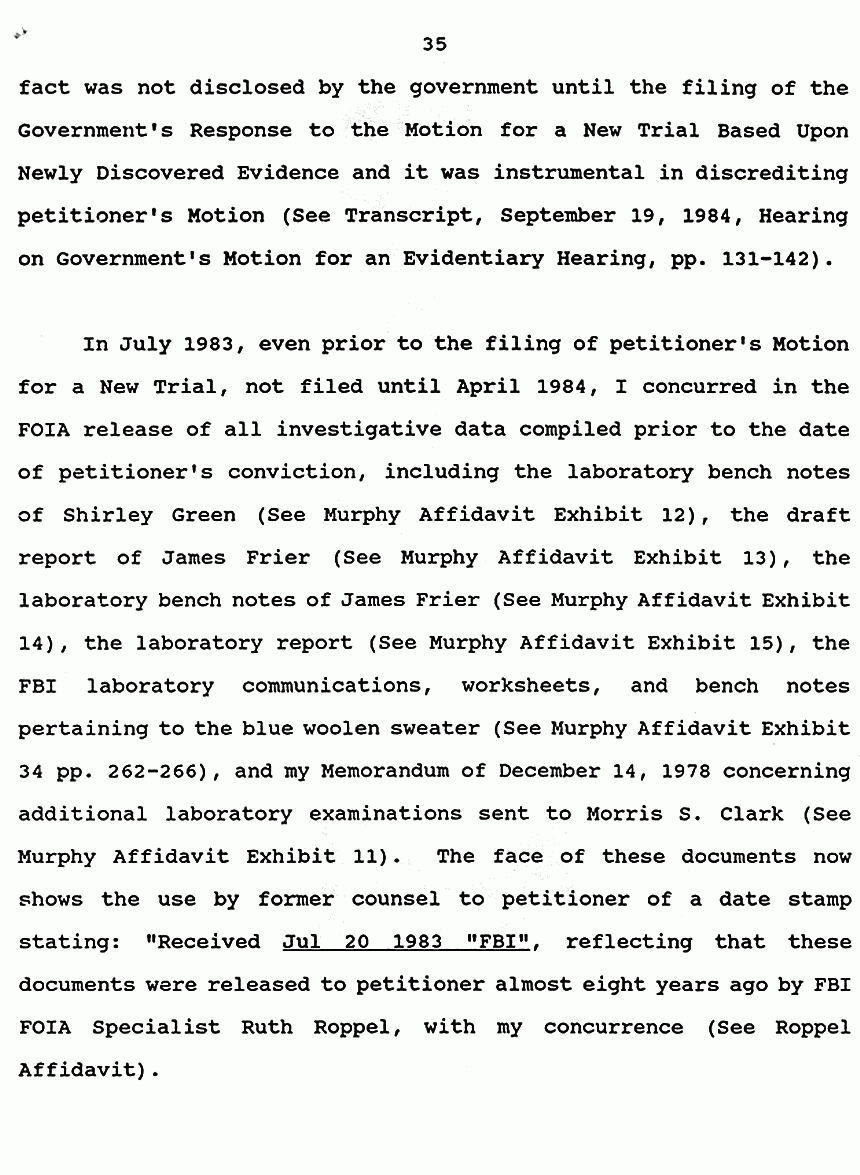
February 19, 1991: Affidavit of Brian Murtagh, page 35 of 37
|
|
February 19, 1991: Affidavit of Brian Murtagh, page 35
Click icon to expand and reduce original image. Drag the expanded image to move it.
|
|
|
|
35
fact was not disclosed by the government until the filing of the
Government's Response to the Motion for a New Trial Based Upon
Newly Discovered Evidence and it was instrumental in discrediting
petitioner's Motion (See Transcript, September 19, 1984, Hearing
on Government's Motion for an Evidentiary Hearing, pp. 131-142).
In July 1983, even prior to the filing of petitioner's Motion
for a New Trial, not filed until April 1984, I concurred in the
FOIA release of all investigative data compiled prior to the date
of petitioner's conviction, including the laboratory bench notes
of Shirley Green (See Murphy Affidavit Exhibit 12), the draft
report of James Frier (See Murphy Affidavit Exhibit 13), the
laboratory bench notes of James Frier (See Murphy Affidavit Exhibit
14), the laboratory report (See Murphy Affidavit Exhibit 15), the
FBI laboratory communications, worksheets, and bench notes
pertaining to the blue woolen sweater (See Murphy Affidavit Exhibit
34 pp. 262-266), and my Memorandum of December 14, 1978 concerning
additional laboratory examinations sent to Morris S. Clark (See
Murphy Affidavit Exhibit 11). The face of these documents now
shows the use by former counsel to petitioner of a date stamp
stating: "Received Jul 20 1983 "FBI", reflecting that these
documents were released to petitioner almost eight years ago by FBI
FOIA Specialist Ruth Roppel, with my concurrence (See Roppel
Affidavit).
|
|
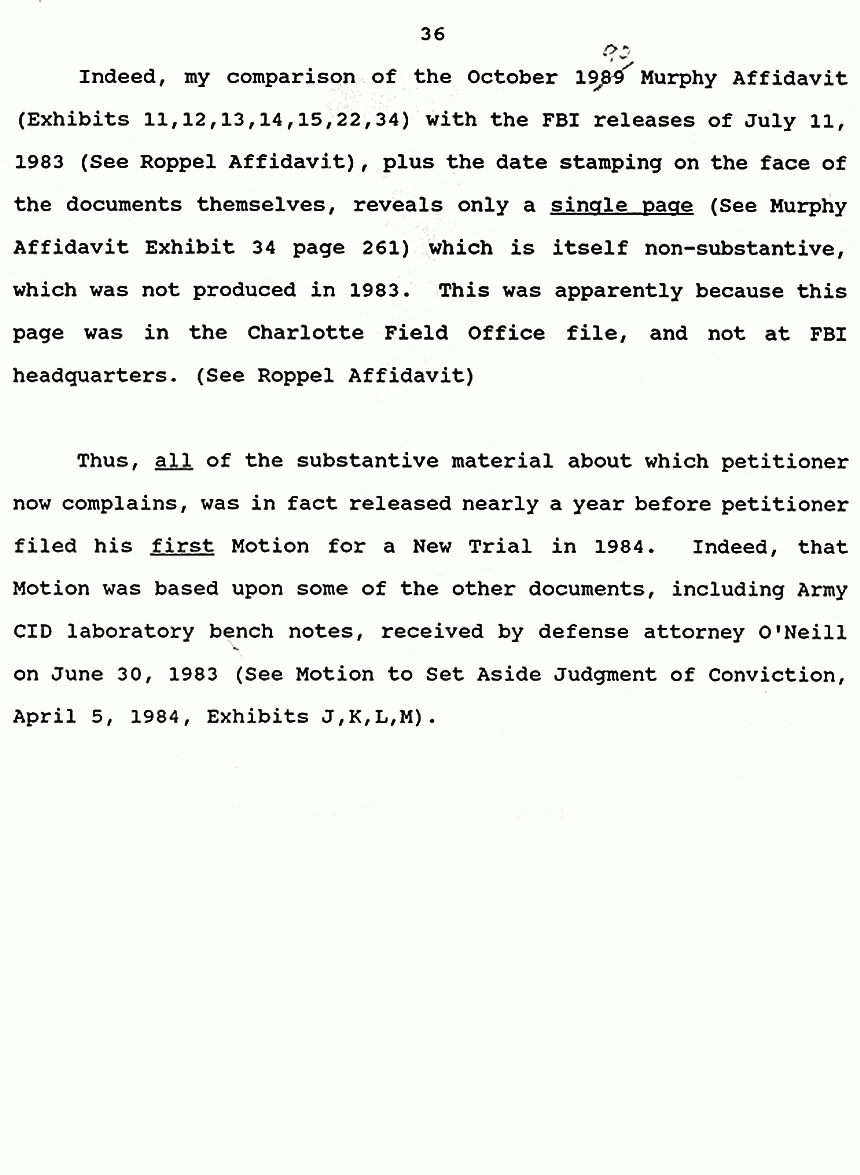
February 19, 1991: Affidavit of Brian Murtagh, page 36 of 37
|
|
February 19, 1991: Affidavit of Brian Murtagh, page 36
Click icon to expand and reduce original image. Drag the expanded image to move it.
|
|
|
36
Indeed, my comparison of the October  ; Murphy Affidavit ; Murphy Affidavit
(Exhibits 11,12,13,14,15,22,34) with the FBI releases of July 11,
1983 (See Roppel Affidavit), plus the date stamping on the face of
the documents themselves, reveals only a single page (See Murphy
Affidavit Exhibit 34 page 261) which is itself non-substantive,
which was not produced in 1983. This was apparently because this
page was in the Charlotte Field Office file, and not at FBI
headquarters. (See Roppel Affidavit)
Thus, all of the substantive material about which petitioner
now complains, was in fact released nearly a year before petitioner
filed his first Motion for a New Trial in 1984. Indeed, that
Motion was based upon some of the other documents, including Army
CID laboratory bench notes, received by defense attorney O'Neill
on June 30, 1983 (See Motion to Set Aside Judgment of Conviction,
April 5, 1984, Exhibits J,K,L,M).
|
|
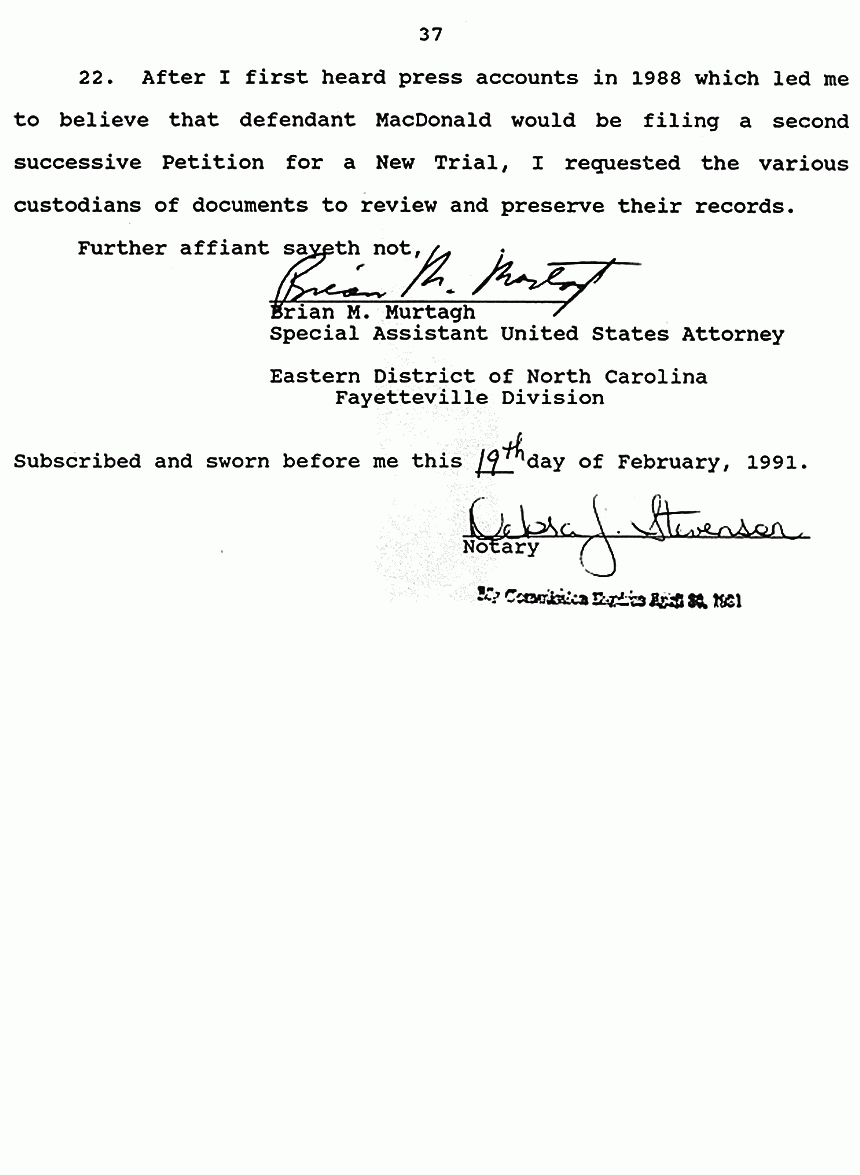
February 19, 1991: Affidavit of Brian Murtagh, page 37 of 37
|
|
February 19, 1991: Affidavit of Brian Murtagh, page 37
Click icon to expand and reduce original image. Drag the expanded image to move it.
|
|
|
|